Applied Concepts ACMI007 Stationary Speed Sensor II User Manual
Applied Concepts Inc Stationary Speed Sensor II
user manual
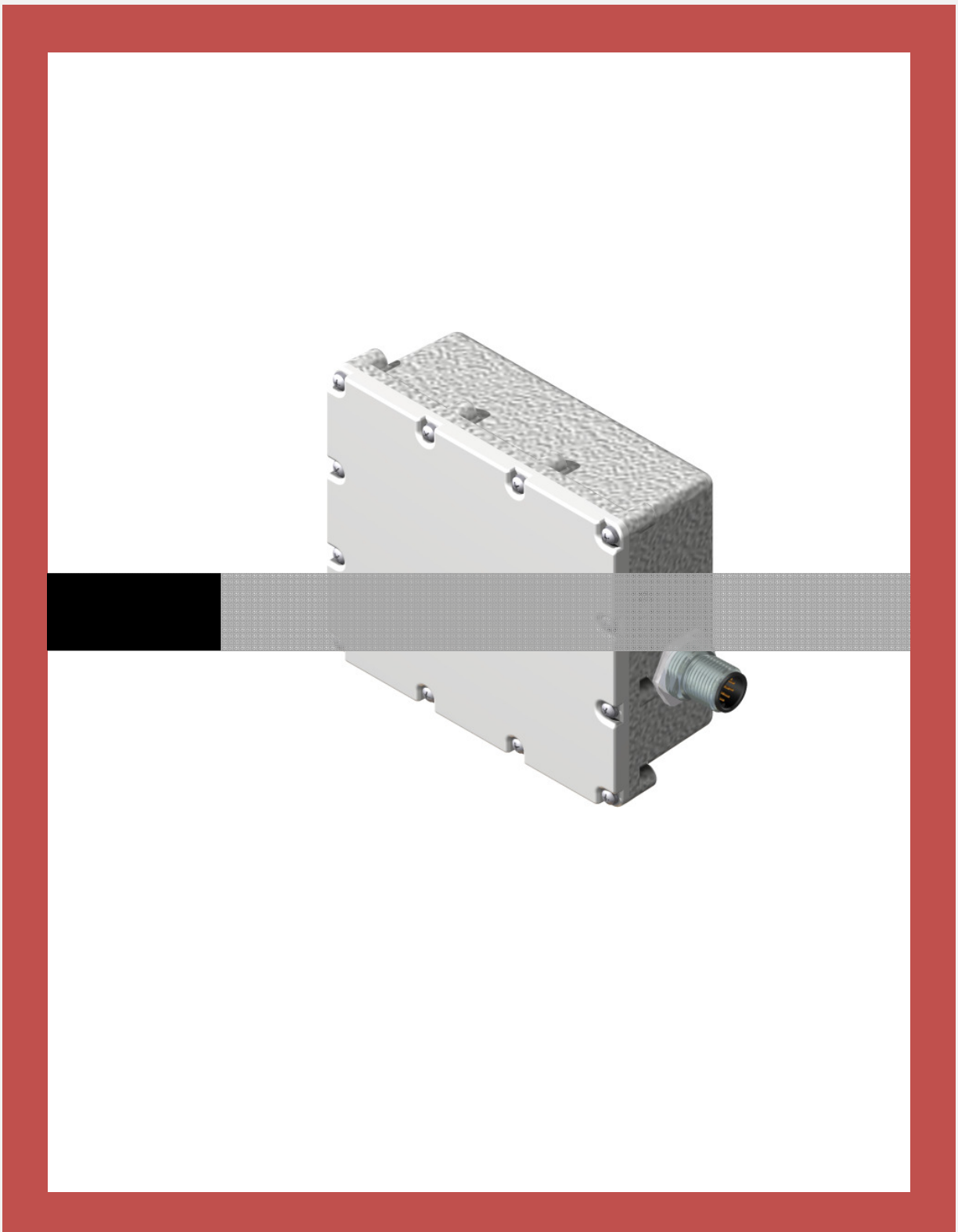
USER'S INSTRUCTION MANUAL
A
PPLIED
C
ONCEPTS
S
TATIONARY
S
PEED
S
ENSOR
II

Applied Concepts 011-0131-00 rev 2 Page 1
Regulatory Statement
Note: This equipment has been tested and found to comply with the limits for a Class A digital
device, pursuant to part 15 of the FCC Rules. These limits are designed to provide reasonable
protection against harmful interference when the equipment is operated in a commercial
environment. This equipment generates, uses, and can radiate radio frequency energy and, if not
installed and used in accordance with the instruction manual, may cause harmful interference to
radio communications. Operation of this equipment in a residential area is likely to cause harmful
interference in which case the user will be required to correct the interference at his own
expense.
Changes or modifications not expressly approved by Applied Concepts, Inc. could void the
user's authority to operate the equipment.
Not intended or approved for Law Enforcement use in the United States.
Stalker/Applied Concepts
2609 Technology Drive
Plano, TX 75074 USA
1-800-STALKER
(972) 398-3750 Sales
(972) 398-3751 Fax
www.stalkerradar.com

Applied Concepts 011-0131-00 rev 2 Page 2
Table of Contents
1 Introduction ............................................................................................................................ 4
2 Specification .......................................................................................................................... 5
3 Quick start.............................................................................................................................. 7
4 Sensor Installation .............................................................................................................. 10
4.1 Housing outline ........................................................................................................... 10
4.2 Electrical connections.................................................................................................... 11
5 Sensor configuration .......................................................................................................... 12
5.2 Simple interface .......................................................................................................... 32
5.3 Communications options ........................................................................................... 32
6 Product support................................................................................................................... 32
6.1 Developers kit.............................................................................................................. 32
6.2 PC Application............................................................................................................. 32
6.3 Loading the Developer’s Kit CD ............................................................................... 32
6.4 Polling for Speed Sensor ID...................................................................................... 32
6.5 Troubleshooting Communication Issues................................................................. 33
7 Configuring the Speed Sensor.......................................................................................... 36
7.1 Reading the Current Configuration .......................................................................... 38
7.2 Changing and Saving the Configuration ................................................................. 39
7.3 Configuration Settings................................................................................................ 41
7.4 Changing the Baud Rate ........................................................................................... 41
7.5 Default Settings........................................................................................................... 41
7.5.1 Factory Defaults .................................................................................................... 41
7.5.2 Configuration File Defaults .................................................................................. 42
7.6 Printing Setting Values............................................................................................... 44
7.7 Fork Test ...................................................................................................................... 44
7.8 Demo Application Soft Keys...................................................................................... 45
7.9 Monitoring Speed Data .............................................................................................. 45
7.10 Logging Speed Data................................................................................................... 47
8 Configuring the Stalker Dashboard Application ............................................................. 48
Application Control File.......................................................................................................... 49
8.1 Speed Sensor Configuration File ............................................................................. 50
8.2 Software updates........................................................................................................ 54
8.3 Checking for a new version of software .................................................................. 54

Applied Concepts 011-0131-00 rev 2 Page 3
8.4 Dashboard Setup........................................................................................................ 54
8.5 Accessories ................................................................................................................. 56
9 Communication Protocols.................................................................................................. 56
10 FCC Requirements.......................................................................................................... 70

Applied Concepts 011-0131-00 rev 2 Page 4
1 Introduction
The Stalker Stationary Speed Sensor is a complete Doppler Radar in a small,
rugged housing. Its direction sensing capabilities and its feature-rich
configuration settings allow it to filter out undesired targets and focus on targets
of interest.
Depending on the model purchased, the Speed Sensor connects to the serial
port on a PC or other controller via an RS-232 or RS-485 link. This interface is
used to configure the unit and to monitor the speed data it sends out. The Speed
Sensor can be configured to report the speeds of targets it acquires in many
formats – from short ASCII character strings to larger data packets with speed
and status information.
The RS-232 models can stream speed data and monitor for commands from the
controller at the same time. The RS-485 models only communicate one way at a
time; they never stream data since they are the slave on the link. They only
respond to commands and speed requests from the controller. They have the
benefit of operating over longer cable distances from the controller, and also
multiple Stationary RS-485 units can be installed in a point-to-multipoint
configuration and controlled from a single serial port on the controller.
The compact, waterproof unit can be mounted almost anywhere. Just supply 9-
16 VDC power, and the Speed Sensor produces serial speed data configured for
your application.

Applied Concepts 011-0131-00 rev 2 Page 5
2 Specification
GENERAL SPECIFICATIONS
Product Type Moving/Stationary Doppler Radar Speed Sensor
Processor Digital Signal Processor
Operating Temperatures -30°C to +70°C (-22°F to +158°F), 90% relative humidity
Storage Temperatures -40°C to +85°C (-40°F to +185°F)
MICROWAVE SPECIFICATIONS
Operating Frequency 24.125 GHz (K-band)
Frequency Stability ±50 MHz
Antenna Type Planar array
3 db Beam Width 24°±1°
Power Output 18 dBm EIRP
ELECTRICAL SPECIFICATIONS
Supply Voltage 10 – 45 VDC
12 – 35 VAC
Current (at 12 VDC
nominal)
Transmitter On: 85 mA
Transmitter Off: 40 mA
PHYSICAL SPECIFICATIONS
Weight 1.15 lb (0.52 kg)
Diameter 2.6 in (6.7 cm)
Length 4.7 in (11.8 cm)
Case Material Aluminum die cast

Applied Concepts 011-0131-00 rev 2 Page 6
PERFORMANCE SPECIFICATIONS
Stationary Speed Range Max target speed: 200 MPH (321 km/h)
Min target speed: Configurable to ~1 or 12 MPH (~1.5 or 19 km/h)
Refer to Stationary Low Cutoff (Setting 7) in Appendices C and D
Vehicle speed
Max vehicle speed for acquisition: 90 MPH (144 km/h)
Max vehicle speed track after acquisition: 199 MPH (320 km/h)
Min vehicle speed for acquisition: Configurable to 5 or 20 MPH (8 or
32 km/h)
Refer to Vehicle Low Cutoff (Setting 8) in Appendices C and D
* The Speedometer Speed Sensor has low-speed capabilities which
allow it to see vehicle speeds down below 1 MPH (1.6 km/h) on the
low setting
Opposite lane target speed
Maximum combined closing speed: 200 MPH (321 km/h)
For 5 MPH (8 km/h) vehicle speed: 20 to 195 MPH (32 to 313 km/h)
For 70 MPH (112 km/h) vehicle speed: 35 to 130 MPH (56 to 209
km/h)
Moving Speed Range
Same lane target speed
Min/Max target speed: vehicle speed ±70%
Also, no targets seen within ±5 MPH (±8 km/h) of vehicle speed.
Vehicle speed must be greater than 16 MPH (25 km/h)
Accuracy +/- 0.3%
In ones resolution, speeds are rounded down to nearest integer.
In tenths resolution, speeds are rounded down to nearest tenth.
Refer to Unit Resolution (Setting 21) in Appendices C and D
Audio Output A 3.3 Vpp pulse-width modulated (PWM) audio output signal is
provided for Doppler audio and status beeps – must be filtered and
amplified for best audio quality.
Only available on Stationary and Traffic Speed Sensor models.
Speed Alarm Output With speeds below the Alarm Threshold, the Aux pin output is 0V.
With speeds at or above the Alarm Threshold, the Aux pin is 3.3V and
can drive 10mA.
Automatic Self Test Performed every 10 minutes (default) while transmitting.
Refer to Auto Test Period (Setting 52) in Appendix D to change the
period in the range from 30 seconds to 15 minutes.
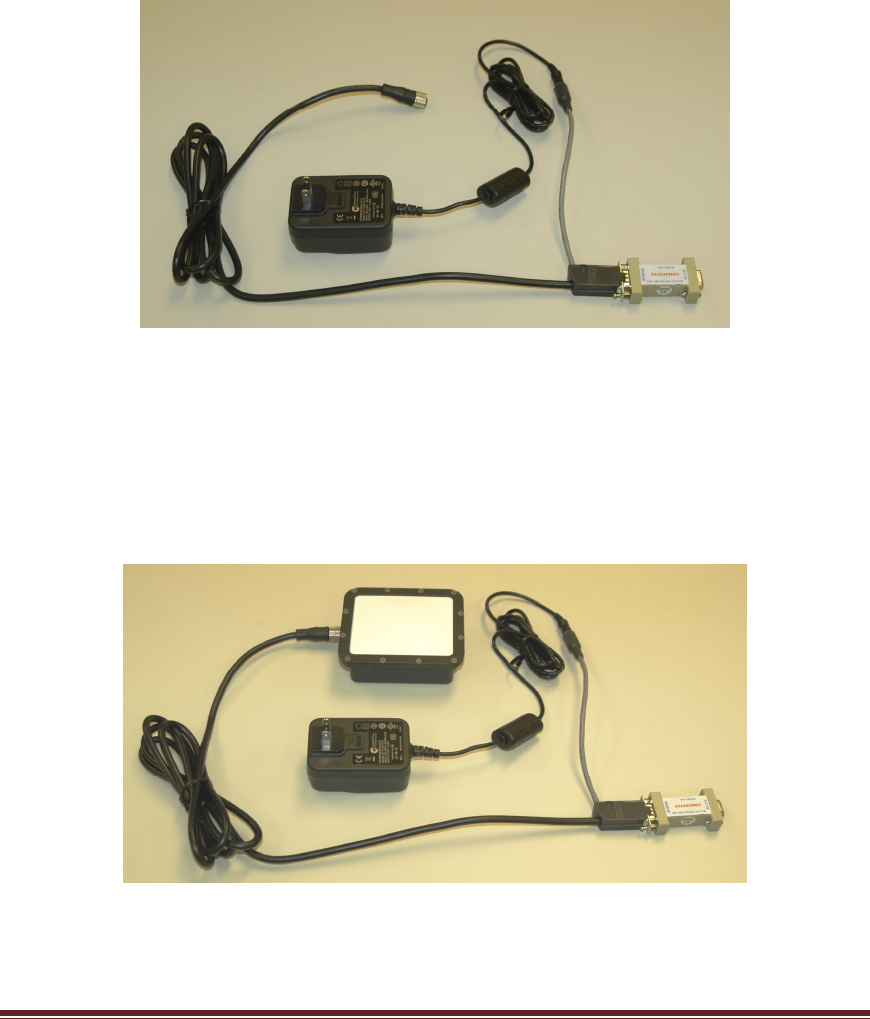
Applied Concepts 011-0131-00 rev 2 Page 7
3 Quick start
The easiest way to start using a Speed Sensor is to connect it to a PC using a S Speed
Sensor Power/Data Kit (200-0925-00). As shown in the pictures below, the cable in the
kit has three connections that go to:
• The S Speed Sensor (sold separately)
• An RS-485 to RS-232 Converter (supplied) for connecting to a PC.
• Power input using a 2.5 x 5.5 DC Plug. The supplied power adapter is a universal
input switching supply that can be used worldwide.
You will need:
• A S Speed Sensor
• A PC with a serial port. For the quickest start, we recommend a PC with a standard
9-pin D serial port connector. If your PC only has USB ports, use a USB to Serial
Adapter Cable.
• A 120-240AC (50-60Hz) power source for the Switching Power Supply - or-
• A 12VDC power source for the optional cigarette plug power cable (015-0182-00)
available from Stalker Radar.
• A S Speed Sensor Power/Data Kit, Stalker Radar part number 200-0925-00.
Quick Start Steps:
1. Connect the Power/Data cable to the Speed Sensor.
2. Connect the RS-485 to RS-232 converter to the DB9 connector.
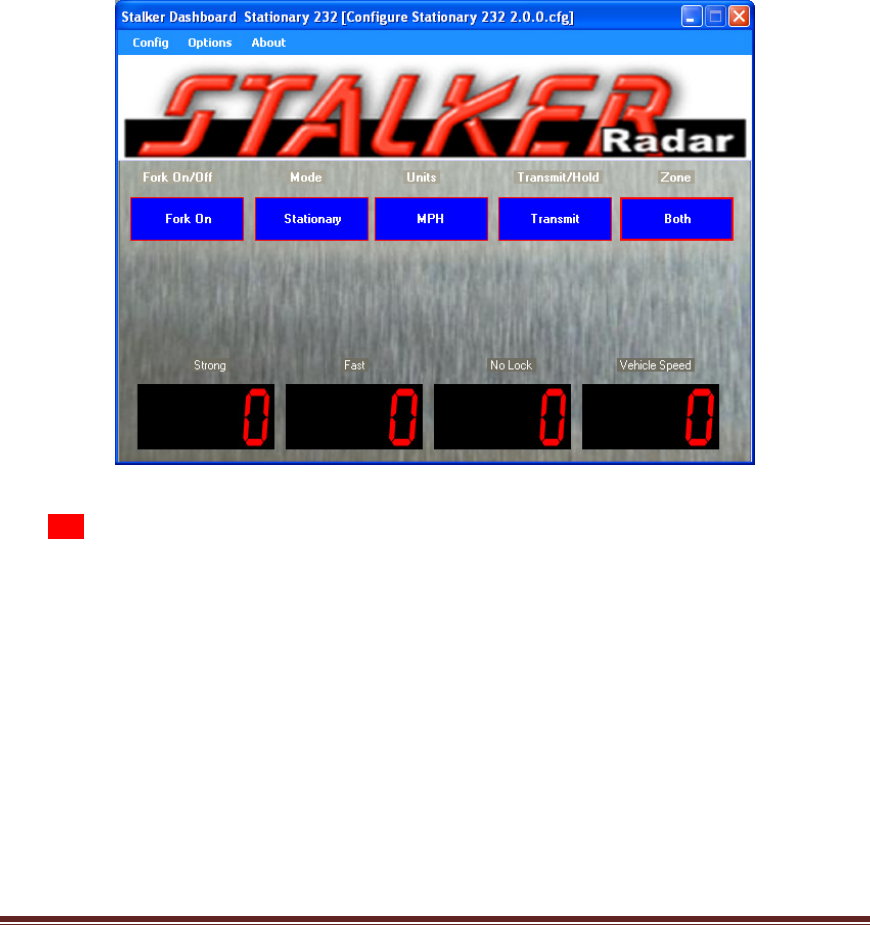
Applied Concepts 011-0131-00 rev 2 Page 8
3. Connect to the PC using the provided serial cable. This is a “straight-through”
serial cable. (Do not replace it with a “null modem” cable which will swap the
transmit and receive wires.
4. Connect to power by plugging the power adapter into the AC line and then plug
the power connector into the Power/Data cable. If using the DC power cable,
then plug the cigarette plug into a 12VDC (nominal) power supply.
5. Load the Developer’s Kit CD on your PC. Insert the disc and allow the
automatic installer to run to completion. You will now have a new icon on your
desktop – a large red S.
6. Open the demo application called Stalker Dashboard to show the main screen
below. The text in the blue title bar at the top of the screen will depend on the
last used configuration file.
7. Make sure the Transmit status shows that the unit is transmitting (Transmit or
Xmit). If it shows as Hold, click on the Transmit/Hold softkey to turn the radar
transmitter on. Using the Mode and Zone softkeys set the Mode to Stationary
and the Zone to Both to see the most targets. The Speedometer Speed Sensor
does not have a stationary mode, so leave it set for Moving mode.
8. Depending on the low speed cutoff selected, you can either move your hand
back and forth in front of the radar lens or point the Speed Sensor toward a
moving object to see speeds displayed in the windows. Targets moving directly
toward or away from the radar are measured with the most accuracy. The radar
can not measure the speed of objects moving across its beam at all. The Speed
Sensor can pick up large and small moving objects as well as unsuspected
targets such as PC fans and leaves blowing in the wind.

Applied Concepts 011-0131-00 rev 2 Page 9
9. If you have a tuning fork, strike it and hold it in front of the radar lens to see its
calibrated speed readout. Reading a fork works best when the Speed Sensor is
in Fork Mode. If the Fork On/OFF status on the main screen shows as Off, click
the soft key to toggle the fork mode to on. At power up, the Speed Sensor
automatically enters Fork Mode for one minute. Since a tuning fork is not a
directional target and only simulates a Doppler frequency, Fork Mode is
provided to turn off the standard directionality filtering in the radar.
Refer to the following sections if there are any problems in the steps above or for a more
thorough description of the basic and advanced features of the Speed Sensors.
Section 3 describes the physical connections of a Speed Sensor to power, to a
computer or controller and to auxiliary external devices.
Section 4 describes details of loading the Developer’s Kit Stalker Dashboard application
CD and the basics of Speed Sensor communications over the controller’s serial port.
Section 5 describes viewing and changing the configuration of a Speed Sensor using
the demo PC application.
Section 6 describes operation of a Speed Sensor using the Stalker Dashboard
application.
Section 7 describes updating the software in the Speed Sensor.
Section 8 describes the control files used to configure the Stalker Dashboard
application and how to tailor their operation to specific user needs.
Section 9 describes the Speed Sensor configuration/control protocol to aid users in
developing their own custom applications.
Section 10 lists the Speed Sensor specifications.
The appendices at the end of the manual contain detailed information for in-depth
understanding of speed sensor operation.
Appendix A contains detailed descriptions of the data fields in the streaming data
protocols.
Appendix B contains the same type of information for the handshake (polled) data
protocols.
Appendix C contains detailed descriptions for each of the control and configuration
settings available on the speed sensors. They are arranged in groups of related
function.
Appendix D contains a table with all of the control and configuration settings listed by
ID number. It shows which settings are available in which speed sensor model and the
factory default settings for each.
Appendix E contains a description of the data fields for the protocol used to control and
configure speed sensors.
Appendix F lists speed sensor accessories available from Stalker Radar.
Appendix G details speed sensor installation for lane discrimination.
Appendix H details speed sensor installation for point-to-multipoint links.
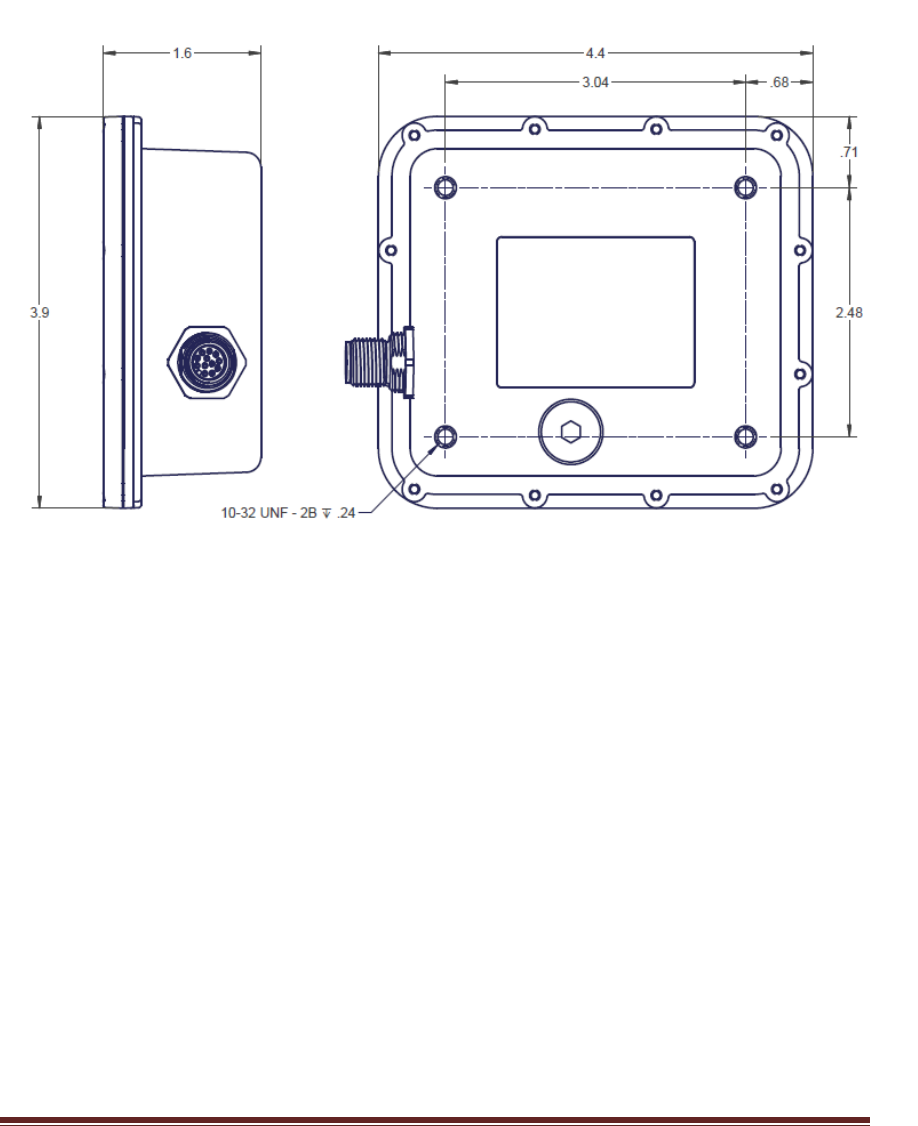
Applied Concepts 011-0131-00 rev 2 Page 10
4 Sensor Installation
4.1 Housing outline
The diagram below show the dimensions of the sensor housing.
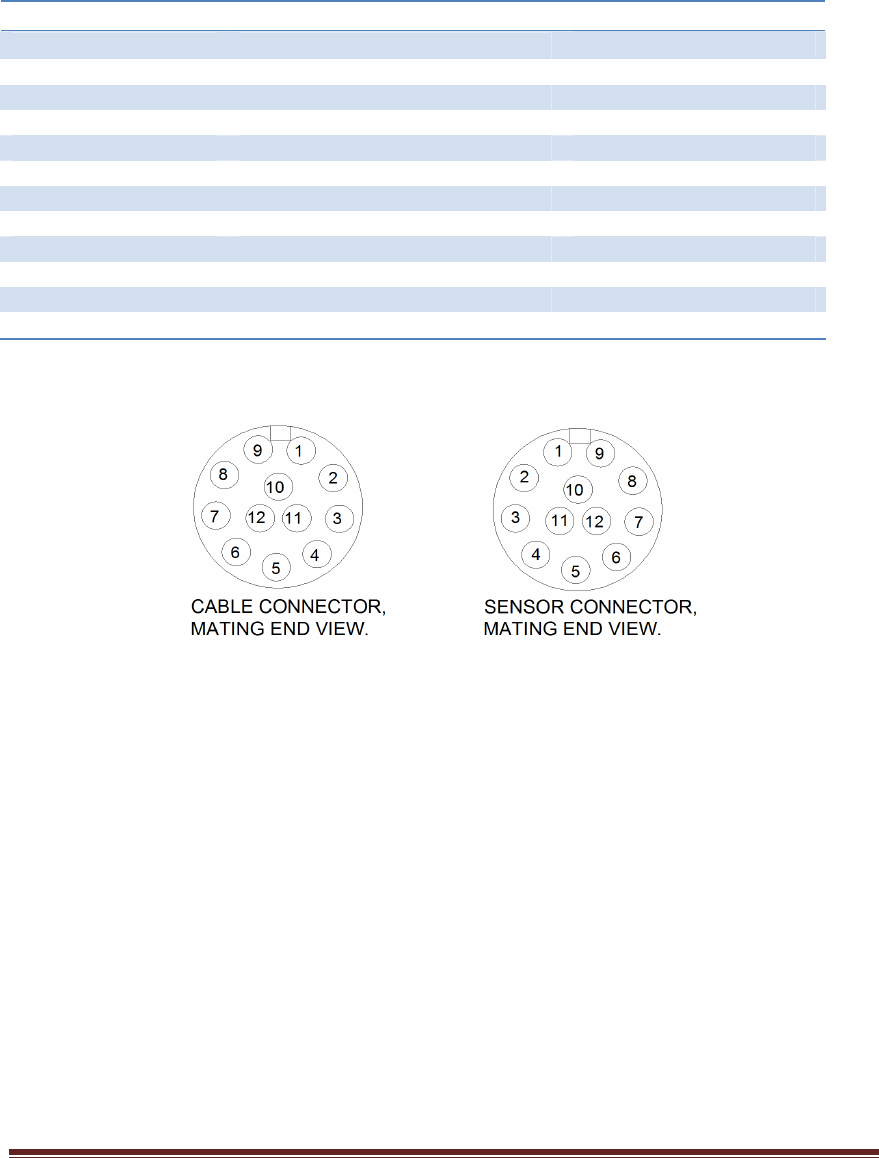
Applied Concepts 011-0131-00 rev 2 Page 11
4.2 Electrical connections
Use the table below to indentify the electrical connections in the external connector.
Pin Number Signal Name Wire Color
1 AC Brown
2 AC Red
3 RS_232 sensor RX Orange
4 Ground Yellow
5 Power Dark Green
6 Relay Blue
7 Relay Violet
8 RS-485 sensor TX+ Gray
9 RS-485 Sensor TX- Black
10 RS-485 Sensor RX+ White
11 RS -232 Sensor TX Pink
12 RS-485 sensor RX- Light Green
The diagrams below shows the pin out of the cable and sensor connectors as mated.
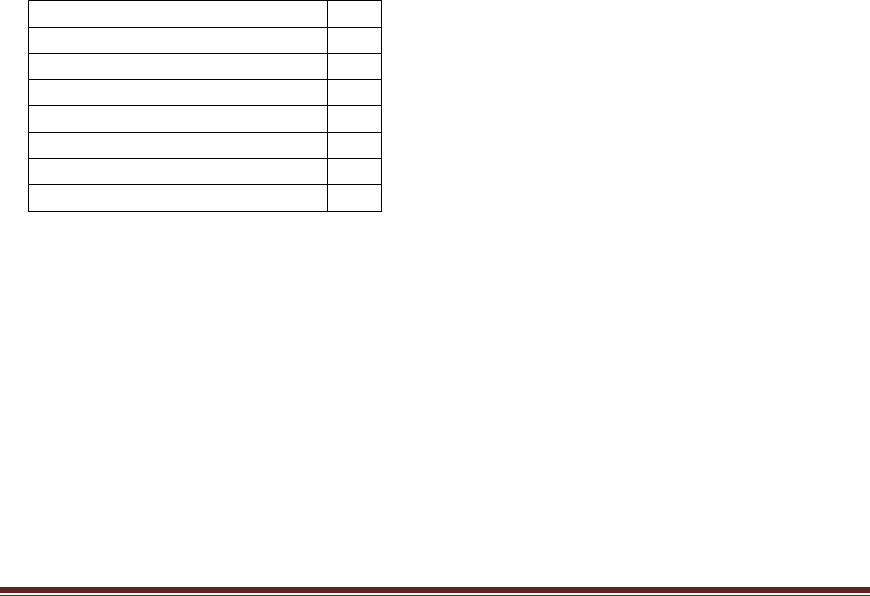
Applied Concepts 011-0131-00 rev 2 Page 12
5 Sensor configuration
5.1.1.1.1.1.1 Configuration Setting Descriptions
All the control and configuration settings available for the Speed Sensors are described
in this Appendix. Here, they are arranged in the following groups of related function.
1. Basic Configuration
2. Serial Port Configuration
3. Target Recognition
4. Target Filtering
5. Speed Presentation
6. Locking Targets
7. Speed Alarm
8. Audio
9. TX Power Save
10. Testing
11. System
Not all settings are available in all models. The table in Appendix D lists all the settings
in order of ID number. It shows all possible values, which settings are available for each
model and the default value for each model. Refer to the table while reading this section
for a better understanding of the settings.
1. Basic Configuration
SETTING ID
Transmitter Control 42
Mode 1
Zone 2
Units 20
Unit Resolution 21
Faster Target Tracking 13
AUX Pin Configuration 16
The Transmitter Control setting (42) turns the radar transmitter on or off and is
available in all models. The transmitter must be on for the radar to register speeds.
The Mode setting (1) can only be changed in the Traffic Speed Sensor model. It is used
to select between moving mode or stationary mode. The Stationary Speed Sensor
models are fixed in stationary mode, and the Speedometer Speed Sensor models are
fixed in moving mode.
The Zone setting (2) tells the radar what zones to look for targets in.
When in stationary mode, the Zone values are Away to monitor receding targets only,
Closing to monitor approaching targets only and Both to monitor targets moving in either
direction.
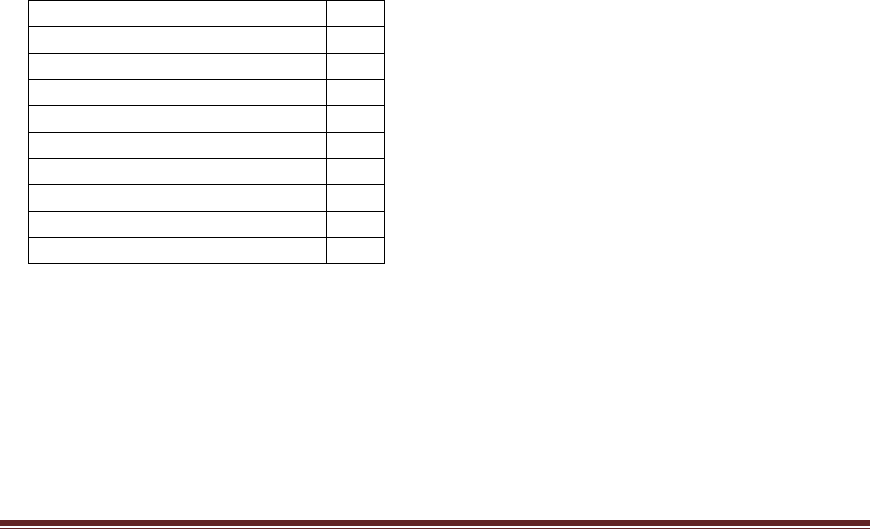
Applied Concepts 011-0131-00 rev 2 Page 13
When in moving mode, the Zone values are Same Lane to monitor targets moving in the
same direction as the radar and Opposite Lane to monitor targets moving in the opposite
direction.
This setting is not available in the Speedometer Speed Sensor models since they only
measure patrol speed.
The Units setting (20) selects the units of speed measurement. The available options
are MPH, km/h, knots, meters/sec or feet/sec.
The Unit Resolution setting (21) can be set to report speeds in whole units, as 25, or
tenths of units, as 25.4. These settings are available on all Speed Sensor models.
The Faster Target Tracking setting (13) allows acquisition and tracking of a faster
target when a slower target has already been acquired as the strong target. An example
of a time when this capability is helpful is when a small car is passing a large truck. The
truck is reported as the main target because of its larger size. The car is then reported
as the fast target.
The Aux Pin Configuration setting (16) sets up the AUX pin for audio, speed alarm or
no function. Refer to the Auxiliary Connections section in Chapter 3 and the Monitoring
the AUX Pin section in Chapter 6 for more details on the physical connections and the
functions of the AUX pin.
When configured for Audio, status beeps and Doppler audio are transmitted from the
AUX pin. Use the settings in Section 8 of this appendix for detailed configuration of the
audio functions.
When configured for the Speed Alarm feature, use the Alarm Speed Threshold setting
described in Section 7 of this appendix to set up the target speed where the speed alarm
activates.
This setting is only available on the Stationary and Traffic models.
2. Serial Port Configuration
SETTING ID
Serial Port Baud Rate 29
Serial Port Output Format 30
Leading Zero Character 23
Direction Character Enable 91
Zeros After Target Loss 98
Message Period 31
Update On Change Only 93
Zero Report 92
Format D Polled Modes 90
Use the settings in this section to configure the speed messages transmitted out the
serial port.
The Serial Port Baud Rate setting (29) configures the baud rate in the range from 300
to 38400. The default value for all Speed Sensor models is 9600 bits per second.
Regardless of the baud rate, the serial port is always configured for 10 bit asynchronous
data with 1 start bit, 8 data bits, 1 stop bit and no parity (8N1).

Applied Concepts 011-0131-00 rev 2 Page 14
After the baud rate setting has been changed in the speed sensor, it does not take
effect until the unit has been powered off and back on. Refer to Section 7.4 for
more details on the steps to take to coordinate the baud rate of the unit and the baud
rate of the Scoreboard application.
The Speed Sensor can transmit speed and status messages out the serial port in
different formats for different applications. The Serial Port Output Format setting (30)
selects the format for transmitted messages. Refer to Appendices A and B for more
details on the message contents for different formats.
The RS-485 Speed Sensor models can not be configured to stream out continuous
speed data because they would never be able to receive a command from the controller.
For this reason, they are limited to the EE handshaking protocols described in Appendix
B and only send out a speed message when requested (or polled) by the controller.
The Stationary RS-485 model can also respond to the more flexible EA handshaking
polls described in Appendix B.
The RS-232 models have more data format options. An RS-232 Speedometer Speed
Sensor can be configured for None, EE, Enhanced Output or B since these formats
report patrol speed. The Traffic model can transmit all of those plus S, A and AF
formats. And the RS-232 Stationary model can be set for all of those so far plus the D0,
D1, D2, D3 and D4 formats.
The F Format is for factory testing only. It is not for general use.
The Leading Zero Character setting (23) defines the character used for leading zeros
on speeds in ASCII message formats (A, AF, B, D0-D3, S). It can be set = 0 for a space
character (ASCII 0x20) or = 1 for a zero character (ASCII 0x30). Examples below show
how different numbers would appear on a speed sign or print-out.
• Space – ASCII spaces are used for leading zero characters
“500”
“ 50”
“ 5”
“ ”
• Zero – ASCII zeros are used for leading zero characters
“500”
“050”
“005”
“000”
The D0, D1, D2 and D3 formats in the RS-232 and RS-485 Stationary model have a field
for a direction character. It indicates “+” for an approaching target, “-“ for a receding
target or “?” if the direction can not be determined. Enable or disable this byte in the
message using the Direction Character Enable setting (91).
Use the Zeros After Target Loss setting (98) to configure what, if any, streaming
messages are sent when no target is present. After a target is lost and when no valid
speeds are detected, the Speed Sensor by default streams messages with speed values
set to zero. As an option, the RS-232 Stationary model can be configured to stop
streaming messages completely after the last valid message until a new target is
acquired. A third option sends one “zero speed” message after the last valid message
before halting the message stream. This single message might be used to clear a
speed board after the last speed was displayed.
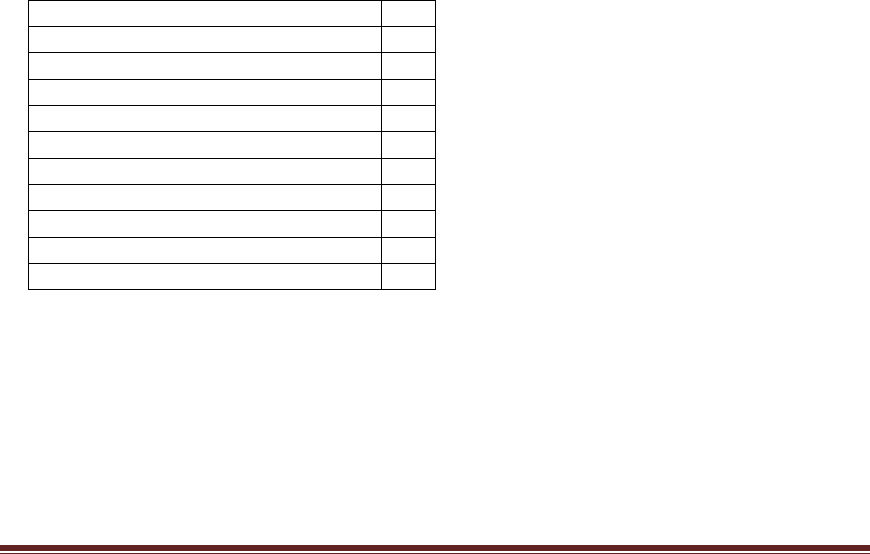
Applied Concepts 011-0131-00 rev 2 Page 15
Beware of changing the Zeros After Target Loss setting from the default “streaming”
value. When no target is present and the Speed Sensor is not transmitting any serial
data, the link can appear broken or dead.
When configured for a streaming message format, the Speed Sensor sends a message
each time the radar generates a new internal speed measurement – about 22 times per
second or every 45 milliseconds. This is the default, and fastest, rate for streaming
messages. If that rate is too fast for a user’s application, it can be slowed down using
the Message Period setting (31). With a range of 0 to 10,000 milliseconds, a delay of
up to 10 seconds can be configured for the time between the beginning of one message
and the next. This feature is available on all of the RS-232 models.
When streaming in any of the D0-D4 formats, another way to limit speed message traffic
on the link is to send a message only when the new speed reading is different from the
last. Enable or disable this feature with the Update On Change Only setting (93).
When it is enabled and there are no targets, the Speed Sensor does not send out any
speed messages, and the link may appear dead.
To turn on a “keep-alive” signal from the unit, enable the Zero Report setting (92) to
configure it to send a zero-speed message every 2 seconds when no target is present.
These two settings are limited to the RS-232 Stationary Speed Sensor model when it is
configured for the D0, D1, D2, D3 or D4 Format.
One last feature that the D0-D4 Formats in the RS-232 Stationary model share is that
they can operate in polled mode like the EE Format. When the Format D Polled Modes
setting (90) is enabled, a speed message is only transmitted after the Speed Sensor
receives a poll message from the controller. The poll is “*P” followed by a carriage
return (in hex: 0x2A, 0x50, 0x0d).
3. Target Recognition
SETTING ID
Ground Speed Sensitivity 3
Patrol Speed Blank 45
Opposite/Stationary Sensitivity 4
Same Lane Sensitivity 5
Fine Sensitivity Adjust 6
Sensitivity Hysteresis 87
Low Sensitivity 54
Target Strength Sensitivity 85
Target Acquisition Quality 55
Target Loss Quality 62
The Ground Speed Sensitivity setting (3) is only available on the Speedometer models
and has the range 1-23. 23 is the most sensitive value and allows acquisition of patrol
speed where there is only a small return signal. 1 is the least sensitive and requires a
large return signal to acquire patrol speed.
When using the Traffic or Speedometer models in moving mode, the unit usually
acquires patrol speed (or ground speed) from the radar reflections off of the unmoving
surroundings: signs, buildings, trees, etc. Occasionally when starting up at an

Applied Concepts 011-0131-00 rev 2 Page 16
intersection, the traffic in front may block the unmoving surroundings. This situation is
called “shadowing” and the patrol speed reported may be the difference between your
speed and the other traffic’s speed. Once the blocking traffic has opened up, the Patrol
Speed Blank command (45) can be used to clear the obviously erroneous speed and
reacquire a proper patrol speed.
Refer also to the Patrol Speed Low Cutoff setting described below in Section 4 of this
appendix for method of controlling shadowing.
The main target sensitivity setting used in stationary mode is controlled by the
Opposite/Stationary Sensitivity setting (4). This setting is also used in moving mode
when monitoring for targets in the opposite lane zone.
The main sensitivity setting used in moving mode when monitoring the same lane zone
is controlled by the Same Lane Sensitivity setting (5). The range of values for each of
these settings is 0 through 4. Use 4 for maximum sensitivity and 1 for minimum
sensitivity. A sensitivity setting of 0 allows no target acquisition at all.
With a higher sensitivity, the Speed Sensor looks as far away as possible for targets and
gives the unit its highest performance. It is also able to “see” smaller targets. Use lower
sensitivity for targets closer to the unit and when you want to restrict it from seeing
smaller objects or objects farther out in the background.
Within each of the main sensitivity levels for Opposite/Stationary and Same Lane
Sensitivity, a finer adjustment may be made using the Fine Sensitivity Adjust setting
(6) with values of 0 (less sensitive) through 3 (more sensitive).
The Sensitivity Hysteresis setting (87) available on the Stationary models can be used
to reduce drop-outs while tracking a target that is right on the edge of a sensitivity step.
Once a target is acquired, the Opposite/Stationary Sensitivity setting is automatically
increased to “hold on” to the target. After it is lost, the Opposite/Stationary Sensitivity
reverts to its previous value. The value of this setting can be for a 0-3 step increase.
Another setting only available on the Stationary models extends the low sensitivity
range. If the normal Opposite/Stationary Sensitivity level 1 is still too sensitive, the Low
Sensitivity setting (54) can be enabled to extend the low range by three more steps.
With Low Sensitivity enabled, the resulting Opposite/Stationary Sensitivity value of 4 is
equivalent to the normal value of 1. Then values 3, 2 and 1 extend the range to lower
sensitivity.
Whereas the Opposite/Stationary and Same Lane Sensitivity settings described above
compare the target strength to the ambient noise from other radar reflections (signal to
noise ratio) to declare acquisition of a target, the Target Strength Sensitivity setting
(85) can be used to acquire or suppress targets depending only on the target’s strength.
A higher value for the Target Strength Sensitivity allows smaller, lower strength targets
to be acquired. A lower value requires the target to be larger/closer before it is acquired.
One application for this feature is Lane Discrimination where it is desired to monitor only
targets in a given lane of traffic and ignore traffic in neighboring lanes. Refer to Stalker
Application Note AN091021.A for details on lane discrimination installations.
Faster target acquisition is not affected by the Target Strength Sensitivity setting, so
faster targets are sometimes reported when the strong target is suppressed. Use the
Faster Target Tracking setting (13) to disable acquisition of these faster targets if
desired.

Applied Concepts 011-0131-00 rev 2 Page 17
Target Acquisition and Loss: Standard radar operation reports a target speed when
analysis of its most recent buffer results in a target meeting the sensitivity requirements
outlined above. Once a target is acquired, it is tracked until it no longer meets those
requirements.
Target Acquisition: To filter out small or intermittent targets, the criteria for target
acquisition may be changed with the Target Acquisition Quality setting (55). Using
this setting, it is possible to specify that a good target be present for at least x of the last
y buffers before declaring acquisition. Using this “x of y” nomenclature, standard
operation uses “1 of 1” target acquisition quality.
As an example of usage, a “2 of 10” target acquisition quality requires only two of the
last ten buffers to meet requirements for a target to be acquired. Whereas a more
stringent “8 of 10” setting requires eight or more of the last ten buffers to meet
requirements.
The y value can be up to 32 buffers or, at about 22 buffers per second, about 1.5
seconds. So the radar can look over the last 1.5 seconds of history to make the
“acquire” decision.
The x value must be less than or equal to y. The values listed in Appendix D for the
Target Acquisition Quality setting are just a few possibilities, and others may be added to
the speed sensor configuration file. The actual value to be sent to the speed sensor is
calculated as (257 * y) – (256 * x).
This setting is only available in the RS-232 and RS-485 Stationary Speed Sensor
models.
Target Loss: To alleviate drop-outs once a target has been acquired, the criteria for
target loss may be changed using the Target Loss Quality setting (62). Using this
setting, it is possible to specify that target loss requires more than n of the last m buffers
to have a bad target. Using this “n of m” nomenclature, standard operation uses “0 of 1”
target loss quality so that a target is lost if any buffer is bad.
As an example of usage, a “2 of 10” target loss quality will declare a loss of target if
more than two of the last ten buffers have bad targets. The “8 of 10” setting would
require more than eight of the last ten buffers to have bad targets and would filter out
more short-term target dropouts.
As above with target acquisition, the m value can be up to 32 buffers or about 1.5
seconds, so the radar can look over that history to decide whether to drop the target.
The n value must be less than m. The values listed in Appendix D for the Target Loss
Quality setting are just a few possibilities, and others may be added to the speed sensor
configuration file. The actual value to be sent to the speed sensor is calculated as (256 *
n) + m.
This setting is only available in the RS-232 and RS-485 Stationary Speed Sensor
models.

Applied Concepts 011-0131-00 rev 2 Page 18
4. Target Filtering
SETTING ID
Stationary Low Cutoff 7
Spurious Speed Filter 117
Patrol Speed Low Cutoff 8
Double Suppression 17
Max AGC Gain 48
Min AGC Gain 49
Get Current AGC Gain 50
Several settings can be used to filter out undesired targets. The first step is to ignore
targets that are not moving in the desired direction. This is accomplished with the Zone
setting (2) as described in the first section of this appendix, Basic Configuration.
In stationary mode, slow target speeds can be filtered out using the Stationary Low
Cutoff setting (7). When set for “high”, targets moving less than ~12 MPH (~19 km/h)
are ignored. This feature can be helpful when monitoring traffic around slow moving
objects like pedestrians or trees blowing in the wind. When set for “low” (the default),
the filter is removed, and targets down to ~1 MPH can be acquired.
This setting is not available in the Speedometer models.
The radar can sometimes “see” spurious targets caused by phenomena such as multi-
path returns. These are usually short-lived instances caused by the changing view of a
target as it moves through its surroundings. In these cases, the sequence of speeds
reported by the unit shows true target speeds which are interrupted by a small number of
speeds that are very different and are not attributable to any other targets present. The
Spurious Speed Filter setting (117) can be used to filter these so that the radar does
not report them.
The default setting of 1 ensures that the radar must see at least one additional
consecutive confirmation of a new reading to report it. With a setting range of 1 through
5, the unit may be configured to require up to five confirmations in a row before reporting
a new speed. When using this configuration option, be aware that reporting of actual
new targets will also be delayed, but the maximum delay (with a setting of 5) is less than
¼ of a second.
This setting is only available in the Stationary models. It is not available in the Traffic or
Speedometer models.
Just as slow targets can be filtered out in stationary mode, slow ground speeds can be
filtered out in moving mode. When the Patrol Speed Low Cutoff setting (8) is
configured for “high”, ground speed is not acquired until the vehicle is moving faster than
~20 MPH. Ignoring low speeds in this way helps to resolve the “shadowing” problem
when accelerating from a stop behind other vehicles.
Shadowing occurs when a large vehicle in front pulls away and the radar senses the
small difference in the large vehicle’s speed versus the patrol vehicle’s as ground speed.
By ignoring low speed differences like this and waiting until achieving a 20 MPH ground
speed when traffic clears enough to get good radar returns from the non-moving
surroundings, shadowing can be greatly reduced.
When there is no blocking traffic, the Patrol Speed Low Cutoff can be set to “low” (the
default) to acquire ground speeds at or below 1 MPH.

Applied Concepts 011-0131-00 rev 2 Page 19
This setting is not available in the Stationary models.
Refer also to the Patrol Speed Blank command described above in Section 3 of this
appendix for another way to handle shadowing.
Another phenomenon, “doubling”, occurs in moving mode when monitoring targets in the
opposite lane. When the radar monitors reflections off of surrounding objects to acquire
patrol speed, it also registers smaller returns at multiples (or harmonics) of the actual
patrol speed. The strongest of these harmonics is at twice the patrol speed, and the
radar algorithms take this into account to suppress erroneous readings generated from
it.
When an opposite lane target travels toward the moving patrol vehicle, the radar sees a
target Doppler return that is the sum of the target’s and the patrol vehicle’s speeds.
After the radar has acquired ground speed, it subtracts that from the target Doppler
return to calculate the opposite target’s over-the-ground speed. If that target is moving
at the same speed as the patrol vehicle, the total Doppler return is twice that of the patrol
vehicle’s speed. This is the same as the strongest harmonic which is suppressed in the
discussion above. But, in this case, there is a target at that speed that should not be
suppressed.
The Double Suppression setting (17) can be used to control the level of suppression of
the doubled patrol speed. If the radar registers opposite lane targets at or near the
patrol speed when no targets are present, increase the value of this setting. Alternately,
if the radar is not registering obvious opposite lane targets that may be near the patrol
speed, reduce the value of this setting.
This setting is only available in the Traffic model.
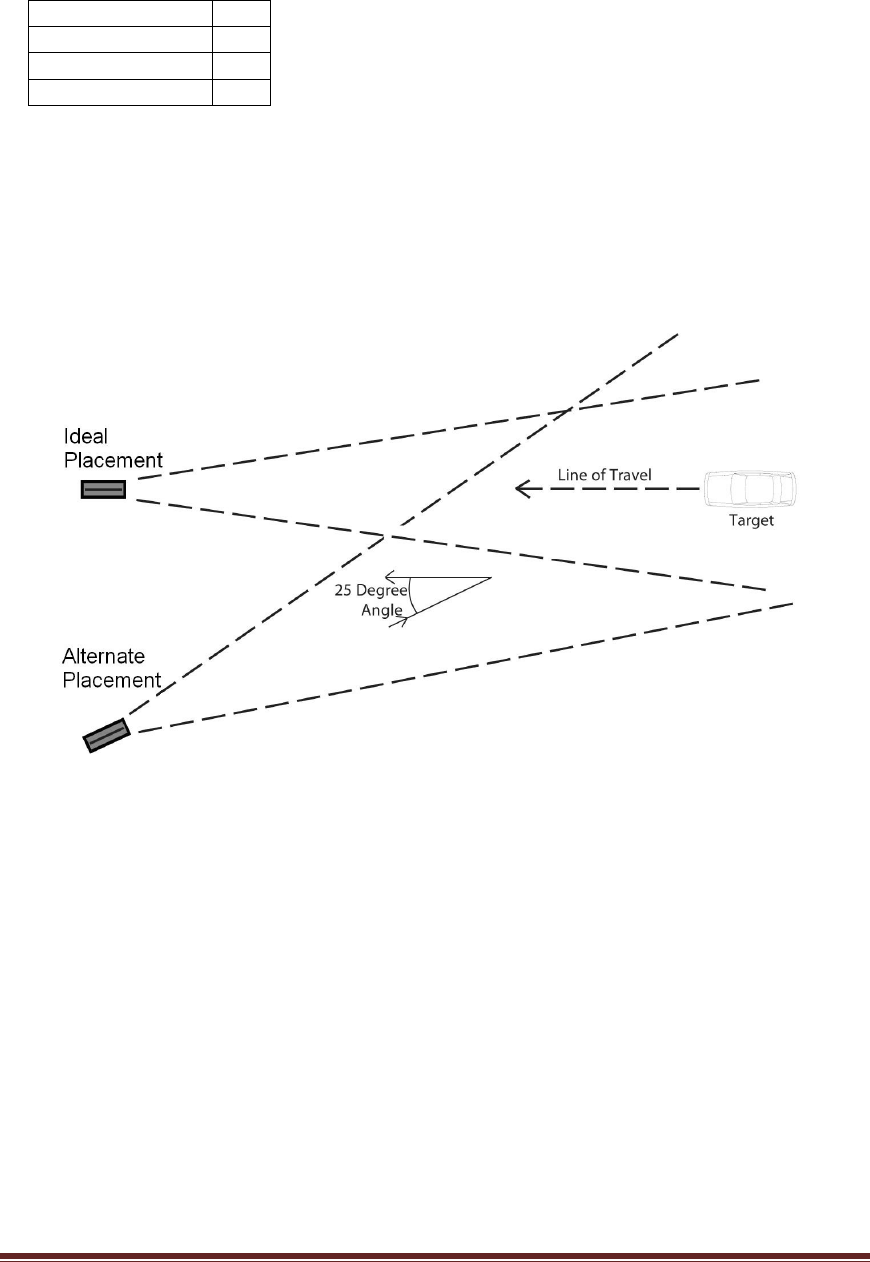
Applied Concepts 011-0131-00 rev 2 Page 20
5. Speed Presentation
SETTING ID
Cosine Angle 1 18
Cosine Angle 2 19
Holdover Delay 88
The internal measurements made by the radar are corrected and presented to the user
depending on the settings in this section.
Speed Sensors measure the most accurate speeds when targets are moving directly
toward or away from them. As with any radar, aiming at an angle results in lower
speeds. At slight angles the error is very small; however at larger angles the error can
become substantial.
On the Stationary Speed Sensor models only, these low speeds can be corrected using
the Cosine Angle settings (18 and 19). Two settings are provided so two corrections
can be made simultaneously. The two settings are independent and interchangeable.
Either one can be used by itself or with the other as a pair. One cosine angle setting
might be used for the horizontal “beside-the-road” angle shown in the diagram above.
The other might be set for the vertical “over-the-road” angle if the Speed Sensor is
mounted on a pole. When the aim of the radar is aligned with the target’s path, the
angle should be set for 0 degrees, and no correction takes place.
The Holdover Delay setting (88) is used to smooth the speed readings during
intermittent dropouts. The Speed Sensor produces speed measurements at a rate of
about 22 measurements per second. When the unit is configured for a streaming
message format, a message is transmitted out the serial port for each measurement.
The radar returns a speed of zero if it is unable to determine a valid speed for any given
measurement time. When conditions are noisy or when the target is very small and
almost out of range, these missed measurements (or dropouts) can make the series of
speed reports appear erratic or jumpy.
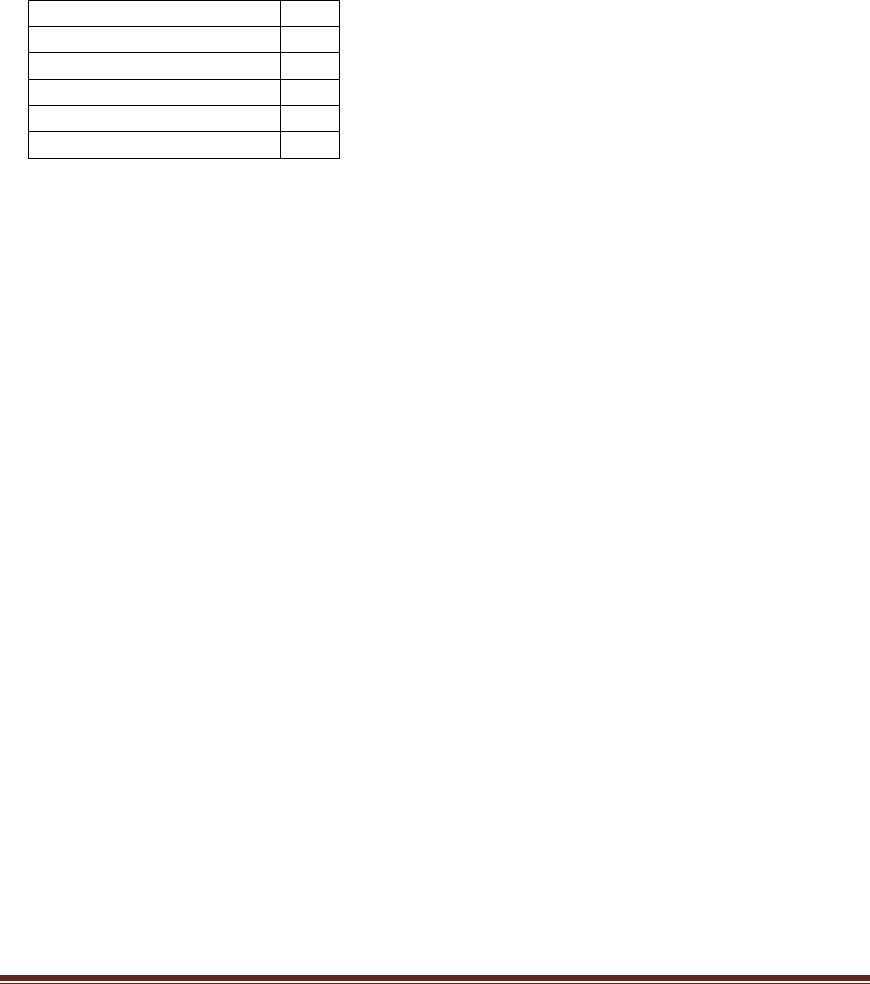
Applied Concepts 011-0131-00 rev 2 Page 21
Rather than interjecting dropouts in the series for invalid speeds, the last valid reading
can be repeated (or held over) to provide continuity for noisy, intermittent targets. The
value of the Holdover Delay setting is the number of measurement times that the last
valid reading can be repeated until another valid speed is determined.
This feature also has the effect of holding over the final speed measurement when a
target disappears.
For all Speed Sensor models, the default Holdover Delay value is 45 periods or about 2
seconds (at ~22 periods per second). The value can be configured in the range from 1
to 222 periods (~10 seconds) on the Stationary and Traffic Speed Sensor models. It is
fixed at 45 periods on the Speedometer Speed Sensor models and can not be changed.
6. Locking Targets
SETTING ID
Lock Option 15
Faster Locking Enable 14
Strongest Lock 43
Fast Lock 44
Patrol Speed Blank 45
While monitoring a target’s changing speed, the Stationary and Traffic Speed Sensors
can “lock-in” the speed at any point in time while still tracking the changing speed of the
target (track-through lock). Either the speed of the largest, strongest target or the speed
of the fast target can be locked. Use the B or Enhance Output Data Format which have
fields to report the locked speed.
The Lock Option setting (15) disables or enables the locking feature for Standard or
Timed operation. When set for Standard locking, the locked speed is held until released
by the user. Timed locking mode also locks and holds the target, but it automatically
releases the locked speed after 15 minutes if the user has not released it by that time.
If locking of fast targets is desired, in addition to enabling the locking feature as
described above and enabling Faster Target Tracking as described in the first section of
this appendix, the Faster Locking Enable setting (14) must also be enabled.
Lock and release speeds using the Strongest Lock (43) and Fast Lock (44)
commands. The current locked speed must be released before any other speed can be
locked.
If in moving mode on the Traffic model, and the Lock Option is set for Standard locking,
the patrol speed is locked in addition to the target. There is not a separate field for the
locked patrol speed in the B or Enhanced Output format, so the locked value just freezes
in the patrol speed field. In Timed locking mode, the patrol speed is not locked.
A locked patrol speed can be blanked out using the Patrol Speed Blank setting (45).
Setting the value =1 requests the Speed Sensor to toggle between zeroing out the
locked patrol speed in the speed message and filling in the field. The Patrol Speed
Blank request is also used to blank and re-acquire patrol speed during normal moving
operation. Refer to the Target Recognition section of this Appendix for more details.
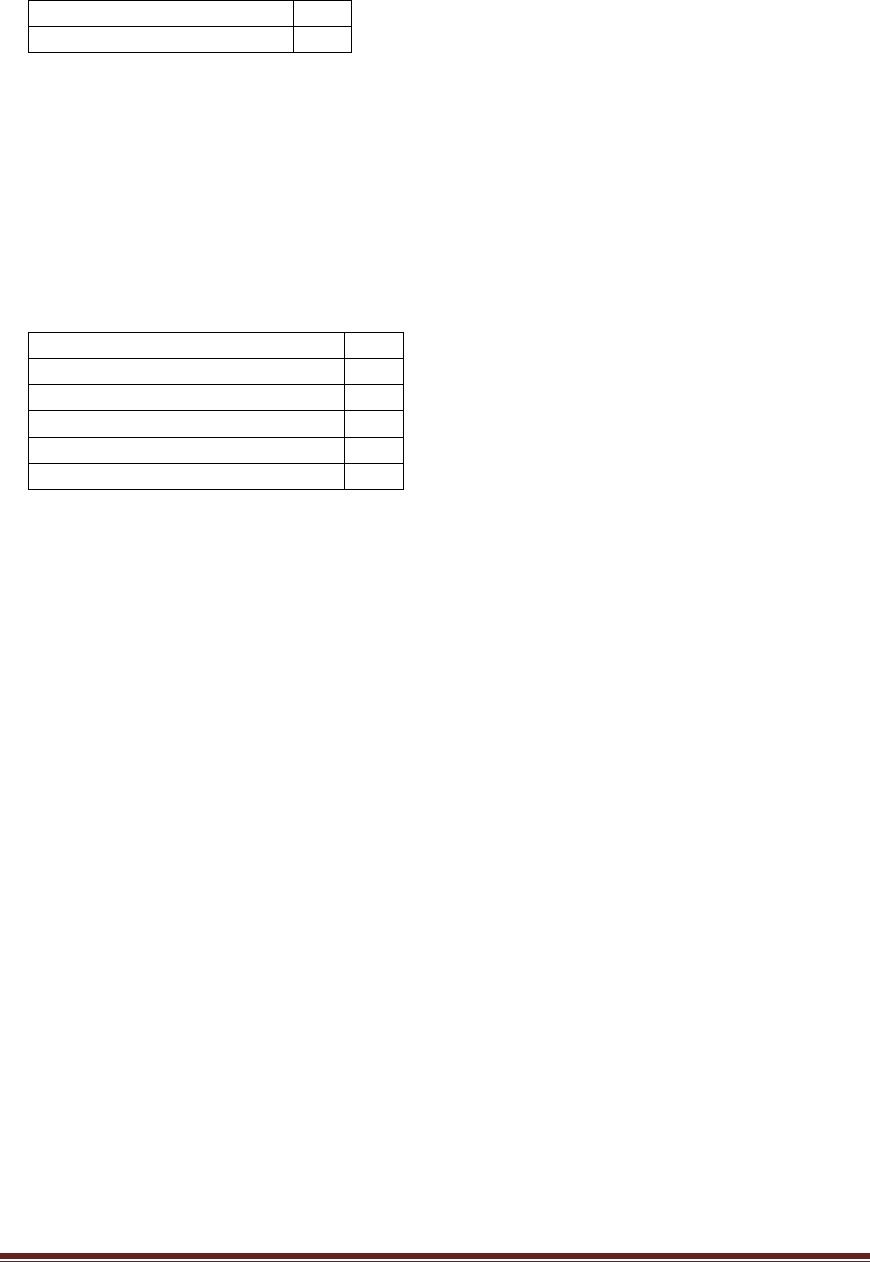
Applied Concepts 011-0131-00 rev 2 Page 22
7. Speed Alarm
SETTING ID
Alarm Speed Threshold 12
The Stationary Speed Sensor models can toggle the AUX pin when a target is traveling
faster than a preset alarm threshold. Ensure the AUX Pin Configuration setting (16) is
for Speed Alarm, and load the Alarm Speed Threshold setting (12) with a value from 0
to 200 MPH. This maximum speed is equivalent to 321 km/h, 173 knots, 89 meters/sec
and 293 feet/sec. Whenever a target goes as fast as or faster than the set value, the
state of the AUX pin changes from FALSE (0V) to TRUE (3.3V). Refer to the Auxiliary
Connections section for details on circuits to interface to the AUX pin.
8. Audio
SETTING ID
Doppler Audio Volume 25
Aud 0 Enable 26
Variable Doppler Loudness 27
Squelch 24
Beep Volume 28
When audio is enabled using the AUX Pin Configuration setting (16), use the settings
described here to configure the audio output. These features are only available on the
Stationary and Traffic models.
Doppler audio is a tone with a pitch that varies with the speed of the strong target. The
pitch rises as the target speeds up and lowers as it slows down. It also varies in
loudness depending on the strength of the target. Audio for a large target is louder than
for a small target far away. These features enable audible tracking of targets and their
changing speeds.
Set the main volume level with the Doppler Audio Volume setting (25). The range of
values is 0 through 4 where 4 is the highest volume, 1 is the lowest, and 0 is Off.
The Off setting can be disabled to only allow steps 1 through 4 with the Aud 0 Enable
setting (26).
The variable loudness can also be disabled to set up a Doppler tone with constant
loudness using the Variable Doppler Loudness setting (27).
The Squelch setting (24) enables or disables the squelch feature. When enabled,
Doppler audio is only generated while a target is present. When disabled and there are
no acquired targets, the low level static from background noise is still audible.
The Speed Sensors also generate beeps for command feedback and status. For
example, there are beeps when changing mode or zone, when turning on or off the radar
transmitter, and when locking and releasing targets. A series of four ascending beeps is
notification that the user or automatic test passed. Set the beep level with the Beep
Volume setting (28). With a value range of 0 through 3, 3 is the highest volume, 1 is the
lowest, and 0 is Off.

Applied Concepts 011-0131-00 rev 2 Page 23
9. TX Power Save
SETTING ID
TX On Time 64
TX Off Time 65
Keep TX On with Target 99
Max TX On Time 100
The TX On Time (64) and TX Off Time (65) settings are available in the Stationary
Speed Sensor models only. They allow the user to set a transmit duty cycle to
automatically turn the transmitter on and off for preset lengths of time. Since the
transmitter is the largest user of power, lowering its duty cycle also lowers the average
power consumed by the Speed Sensor. This power reduction will increase the unit’s run
time when it is powered from a battery source.
The range for both of these settings is 0-60000 ms (0-60 sec). If either is set for 0, there
is no duty cycle, and the transmitter is controlled by the Transmitter Control setting (42)
only. If, for example, TX On Time is set for 400 ms and TX Off Time is set for 600 ms,
the duty cycle is 40% and the period is 1000 ms (or 1 second).
The TX On Time may be extended when a target is present for continuous tracking. And
this extended time may be limited to force the transmitter off again after a preset tracking
time. The Keep TX On with Target setting (99) must be enabled to extend the TX On
Time as long as a target is present.
When that setting is enabled, the Max TX On Time setting (100) forces the transmitter
off even if a target is still present. The range for this setting is 0-60000 ms (0-60 sec).
When set to 0, the maximum transmit time is infinite; the transmitter is never forced off
as long as a target is present.
10. Testing
SETTING ID
Get Product ID 37
Fork Enable 47
Auto Test Period 52
Auto Test Mode 53
Test 46
Enhanced Test 76
All models of Speed Sensors have the test features described in this section and can run
several different kinds of tests – from testing the communication link to its controller, to
testing the ability to register speeds, to internal system tests to check timing and antenna
functions.
A simple test to confirm that the serial link is active is for the controller to query the unit
with the read-only Get Product ID command (37). The return message from the Speed
Sensor contains an ASCII string with the product model name and the version of
software loaded into it. An example is “Stationary Ver: 1.1.0”. This value can not be
changed by the user; it is a constant value and only changes when a new software
version is loaded at the factory.

Applied Concepts 011-0131-00 rev 2 Page 24
The demo application sends this query when reading the Product ID as described in the
Polling for Speed Sensor ID section.
Tuning forks can be used to verify that the radar is able to register accurate speeds.
They can be calibrated to ring at a frequency equal to the Doppler frequency for a given
speed and thus emulate a target. Since the Speed Sensors normally acquire only
directional targets and since tuning forks are non-directional and only simulate a speed,
the Speed Sensor must be configured to ignore the directionality requirement of target
acquisition.
Use the Fork Enable setting (47) to accomplish this. At power-up of the Speed Sensor,
the fork mode is automatically enabled for one minute to allow for a quick fork test.
Strike the fork and hold it in front of the Speed Sensor lens (thin edge toward the lens) to
ensure that the simulated speed is acquired and reported by the unit. After the minute is
up, fork mode is automatically disabled, and the radar focuses only on directional targets
again.
Fork mode may be turned on at any time by setting Fork Enable to On. Whenever it is
enabled by the user like this, it will stay on for ten minutes before automatically turning
itself off. It may be turned off at any time before its automatic timeout by setting Fork
Enable to Off.
A 40 MPH fork is available from Stalker Radar and is listed with other accessories in
Appendix F.
The Speed Sensors automatically run tests periodically to monitor internal timing and
antenna functions. The time between tests is set using the Auto Test Period setting
(52) and can range from 30 seconds to 900 seconds (15 minutes). However the
Speedometer models are fixed at a 600 second (10 minute) test period.
Use the Auto Test Mode setting (53) to configure the unit to run the tests only when the
radar transmitter is on or to run them whether the transmitter is on or off (always). Once
again the Speedometer models are not configurable and are fixed to test only when the
transmitter is on.
Although the testing is performed automatically at the designated period, the user may
also initiate a test using the Test command (46) with a value of 1. In this case, after the
internal test is complete, a 60 second fork mode is entered as described above.
The Enhanced Test command (76) operates in the same manner as the Test command
above, but it also returns a test result value. Since the test takes some time to run, the
response to this command will not be as fast as other commands. Expect an 800-900
ms delay between command and response.
If no problems are identified during a test, the return value is a hexadecimal 0. If any
problems are found, the return value is non-zero. Contact Stalker Radar Customer
Service for assistance in determining the cause(s) behind any failure code.

Applied Concepts 011-0131-00 rev 2 Page 25
11. System
SETTING ID
Get Product ID 37
Get Product Type 79
Get Software Version 81
Speed Sensor Address 116
The settings (or commands) in this section are used to query the Speed Sensor for
information about itself. The values can not be changed by the user; they are constant
and depend on the model of the unit and version of software loaded into it.
A Speed Sensor responds to a Get Product ID command (37) with an ASCII string
containing the product model name and the version of software loaded into it. An
example is “Stationary 232 Ver: 1.1.0”.
The response to a Get Product Type command (79) is a three byte hexadecimal value
associated with the model of the Speed Sensor. The values are:
0xB011CE Traffic Speed Sensor
0x2A11E4 Stationary 232 Speed Sensor
0x4E11A2 Stationary 485 Speed Sensor
0x5BEED0 Speedometer 232 Speed Sensor
0x0DEEB5 Speedometer 485 Speed Sensor
The Get Software Version command (81) returns an ASCII string with the loaded
software’s version. e.g. “1.1.0”
The last setting in this section, Speed Sensor Address (116), controls the address/ID of
the unit used in control and configuration applications as described in Section Error!
Reference source not found.. All RS-232 models and the Speedometer RS-485 model
have an address of 2 which can not be changed.
Since multiple Stationary RS-485 models can be used on the same point-to-multipoint
link, they must have different addresses. Their address range is 2-254 (0x02 – 0xFE).
When shipped from the factory all units have an address of 2, but the user can change a
Stationary RS-485 unit’s address using this command.
Once the address is changed in this manner, the unit will retain the new address until
changed using the same method. A hard reset of the unit or loading a new version of
software changes all other configuration settings to the factory defaults, but the unit’s
address does not change.
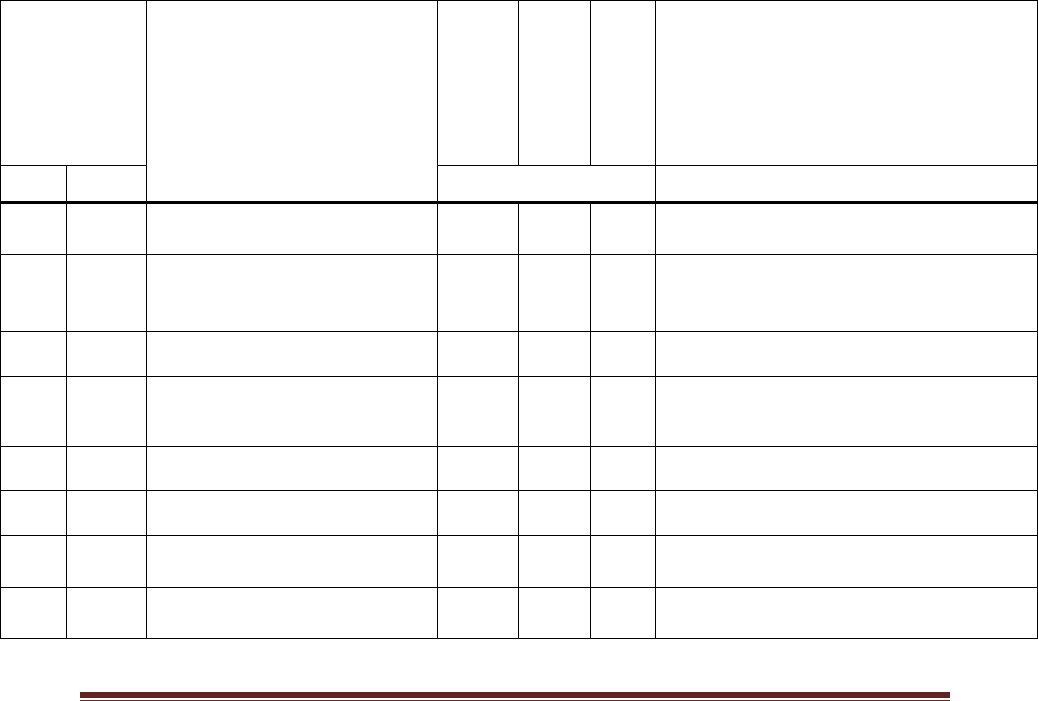
Applied Concepts 011-0131-00 rev 2 Page 26
5.1.1.1.1.1.2 Configuration Settings Table
All of the settings available for the Speed Sensors are listed below in numerical order of
the Setting ID.
The Setting ID column shows the setting ID number in decimal and hexadecimal
representations.
The Setting Description column shows the setting names. It also has references to the
section in Appendix C where the setting is described in detail.
The Default Setting columns contain the factory default values for each setting and for
each of the Speed Sensor models.
-- in any of these columns means that the setting is not supported for that model.
√ in any of these columns means that the setting is not used to configure a setting. It is
used to request an action or status from the Speed Sensor.
The Available Values column shows all possible values for each setting. Some values
may not be available for all Speed Sensor models, so refer to the setting’s description in
Appendix C for details.
Setting ID
Stationary
232 & 485
Speedometer
232 & 485
Traffic
232
Available Values
Dec Hex
Setting Description
Appendix C Ref
Default Setting
1 0x01 Mode
1 – Basic Configuration
0 1 1 0 = Stationary
1 = Moving
2 0x02 Zone
1 – Basic Configuration
2 1 1
0 = Away(Sta)/Same(Mov)
1 = Closing (Sta)/Opposite(Mov)
2 = Both (Sta)
3 0x03 Ground Speed Sensitivity
3 – Target Recognition
-- 23 -- 1 (min) – 23 (max)
4 0x04
Opposite/Stationary
Sensitivity
3 – Target Recognition
4 -- 4 0 (min) – 4 (max)
5 0x05 Same Lane Sensitivity
3 – Target Recognition
-- -- 3 0 (min) – 4 (max)
6 0x06 Fine Sensitivity Adjust
3 – Target Recognition
3 -- 3 0 (min) – 3 (max)
7 0x07 Stationary Low Cutoff
4 – Target Filtering
0 -- 0 0 = “low” (~1 MPH)
1 = “high” (12 MPH/19 km/h)
8 0x08 Patrol Speed Low Cutoff
4 – Target Filtering
-- 0 0 0 = “low” (~1 MPH)
1 = “high” (20 MPH/32 km/h)

Applied Concepts 011-0131-00 rev 2 Page 27
Setting ID
Stationary
232 & 485
Speedometer
232 & 485
Traffic
232
Available Values
Dec Hex
Setting Description
Appendix C Ref
Default Setting
12 0x0C Alarm Speed Threshold
7 – Speed Alarm
200 -- 200
0 – 200 (MPH units)
0 – 321 (km/h units)
0 – 173 (knots units)
0 – 89 (meters/sec units)
0 – 293 (feet/sec)
(can be a two byte value)
13 0x0D Faster Target Tracking
1 – Basic Configuration
1 -- 1 0 = Disabled
1 = Enabled
14 0x0E Faster Locking Enable
6 – Locking Targets
1 -- 1 0 = Disabled
1 = Enabled
15 0x0F Lock Option
6 – Locking Targets
1 -- 1
0 = Off (locking disabled)
1 = Standard
2 = Timed (15 min timeout)
16 0x10 AUX Pin Configuration
1 – Basic Configuration
1 -- 0
0 = Audio (PWM) Doppler & Beeps
1 = Disabled
2 = Speed Alarm
17 0x11 Double Suppression
4 – Target Filtering
-- -- 3 0 (no suppression) – 5 (max)
18 0x12 Cosine Angle 1
5 – Speed Presentation
0 -- -- 0-45 degrees (1° increments)
19 0x13 Cosine Angle 2
5 – Speed Presentation
0 -- -- 0-45 degrees (1° increments)
20 0x14 Units
1 – Basic Configuration
0 0 0
0 = MPH
1 = km/h
2 = knots
3 = meters/sec
4 = feet/sec
21 0x15 Unit Resolution
1 – Basic Configuration
0 0 0 0 = ones
1 = tenths
23 0x17 Leading Zero Character
2 – Serial Port Configuration
0 0 0 0 = space (ASCII 0x20)
1 = zero (ASCII 0x30)
24 0x18 Squelch
8 – Audio
1 -- 1 0 = Disabled
1 = Enabled
25 0x19 Doppler Audio Volume
8 – Audio
1 -- 1 0 (off) – 4 (max)
26 0x1A Audio 0 Enable
8 – Audio
1 -- 1 0 (off) or 1 (on)
27 0x1B Variable Doppler Loudness
8 – Audio
1 -- 1 0 = Constant Loudness
1 = Variable Loudness
28 0x1C Beep Volume
8 – Audio
1 -- 1 0 (off) – 3 (max)

Applied Concepts 011-0131-00 rev 2 Page 28
Setting ID
Stationary
232 & 485
Speedometer
232 & 485
Traffic
232
Available Values
Dec Hex
Setting Description
Appendix C Ref
Default Setting
29 0x1D Serial Port Baud Rate
2 – Serial Port Configuraton
5 5 5
0 = 300 baud 4 = 4800 baud
1 = 600 baud 5 = 9600 baud
2 = 1200 baud 6 = 19200 baud
3 = 2400 baud 7 = 38400 baud
30 0x1E Serial Port Output Format
2 – Serial Port Configuraton
232
2
&
485
1
232
2
&
485
1
2
0 = None (no serial output)
1 = EE Format
2 = Enhanced Output
3 = B Format
4 = S Format
5 = F Format
6 = A Format
7 = AF Format
8 = D0 Format
9 = D1 Format
10 = D2 Format
11 = D3 Format
12 = D4 Format
31 0x1F Message Period
2 – Serial Port Configuraton
0 0 0 0 – 10000 ms (10 sec) message
delay
37 0x1F Get Product ID
10 – Testing
11 - System
√ √ √
1 = Request the return of an ASCII
string containing product model and
software version (read only)
42 0x2A Transmitter Control
1 – Basic Configuration
1 1 1 0 = Transmitter off (Hold)
1 = Transmitter on
43 0x2B Strongest Lock
6 – Locking Targets
0 -- 0 0 = Release
1 = Lock
44 0x2C Fast Lock
6 – Locking Targets
0 -- 0 0 = Release
1 = Lock
45 0x2D Patrol Speed Blank
3 – Target Recognition
6 – Locking Targets
-- √ √
1 = Re-acquire patrol speed or (in
Traffic model only) if speed is
locked, toggle locked patrol speed
on and off
46 0x2E Test
10 – Testing
√ √ √ 1 = Initiate internal test
47 0x2F Fork Enable
10 - Testing
0 0 0 0 = Fork mode off (normal)
1 = Fork mode on (non-directional)
48 0x30 Max AGC Gain
4 – Target Filtering
7 7 7 0 (low gain) – 7 (high gain)
Max >= Min
49 0x31 Min AGC Gain
4 – Target Filtering
0 0 0 0 (low gain) – 7 (high gain)
Min <= Max
50 0x32 Get Current AGC Gain
4 – Target Filtering
√ √ √ Returns current AGC gain
(read only)

Applied Concepts 011-0131-00 rev 2 Page 29
Setting ID
Stationary
232 & 485
Speedometer
232 & 485
Traffic
232
Available Values
Dec Hex
Setting Description
Appendix C Ref
Default Setting
52 0x34 Auto Test Period
10 – Testing
600 600 600
30-900 seconds
(can be a two byte value)
(Speedometer models fixed at 600.)
53 0x35 Auto Test Mode
10 - Testing
0 1 0
0 = Always Test
1 = Test only when radar transmitter
is on
(Speedometer models fixed at 1)
54 0x36 Low Sensitivity
3 – Target Recognition
0 -- -- 0 = Disabled
1 = Enabled
55 0x37 Target Acquisition Quality
3 – Target Recognition
1 of 1 -- --
1 of 1, 1 of 10, 2 of 10, 3 of 10, 4 of
10, 5 of 10, 6 of 10, 7 of 10, 8 of 10,
9 of 10, 1 of 30, 29 of 30 (or any
combination of x and y where target
acquisition requires >= x of the last y
buffers to have good signal to noise;
y must be in range 1-32; x must be
<= y)
(can be a two byte value)
62 0x3E Target Loss Quality
3 – Target Recognition
0 of 1 -- --
0 of 1, 1 of 10, 2 of 10, 3 of 10, 4 of
10, 5 of 10, 6 of 10, 7 of 10, 8 of 10,
9 of 10, 1 of 30, 29 of 30 (or any
combination of n and m where target
loss requires > n of the last m
buffers to have bad signal to noise;
m must be in range 1-32; n must be
< m)
(can be a two byte value)
64 0x40 TX On Time
9 – TX Power Save
0 -- --
65 0x41 TX Off Time
9 – TX Power Save
0 -- --
Range for both is 0-60000 ms (0-60
sec) (can be a two byte value).
These values provide a transmit
on/transmit off duty cycle. If either is
= 0, there is no duty cycle, and the
transmitter is controlled by setting 42
only.
76 0x4C Enhanced Test
10 - Testing
√ -- √ 0 = Get last test result
1 = Initiate test and return result
79 0x4F Get Product Type
11 - System
√ -- √
1 = Request the return of a three
byte code associated with the
product model (read only)
81 0x51 Get Software Version
11 - System
√ -- √
1 = Request the return of an ASCII
string containing the software
version (read only)

Applied Concepts 011-0131-00 rev 2 Page 30
Setting ID
Stationary
232 & 485
Speedometer
232 & 485
Traffic
232
Available Values
Dec Hex
Setting Description
Appendix C Ref
Default Setting
85 0x55 Target Strength Sensitivity
3 – Target Recognition
32 -- -- 1 (min) – 32 (max)
87 0x57 Sensitivity Hysteresis
3 – Target Recognition
0 -- -- 0 – 3
88 0x58 Holdover Delay
5 – Speed Presentation
45 45 45
Stationary and Traffic: 1 – 222 (~10
sec)
Speedometer: fixed at 45 (~2 sec)
90 0x5A Format D Polled Modes
2 – Serial Port Configuration
0
232
only
-- --
0 = Polled Mode Disabled
1 = Polled Mode Enabled
Active for Serial Formats D0-D4 only
91 0x5B
Format D Direction
Character Enable
2 – Serial Port Configuration
0 -- --
0 = Direction Character Disabled
1 = Direction Character Enabled
Enable Direction byte, Formats D0-
D3 only
92 0x5C Format D Zero Report
2 – Serial Port Configuration
0
232
only
-- --
0 = Disabled
1 = Enabled
Active only if setting 93 is enabled.
With no target, sends zero every two
seconds.
93 0x5D
Format D Update on
Change Only
2 – Serial Port Configuration
0
232
only
-- --
0 = Disabled
1 = Enabled
Enables speed reporting only when
the speed changes.
Active for Serial Formats D0-D4 only
98 0x62 Zeros After Target Loss
2 – Serial Port Configuration
2
232
only
-- --
0 = No Zeros
1 = One Zero
2 = Stream Zeros
99 0x63 Keep TX On with Target
9 – TX Power Save
0 -- --
0 = Disabled
1 = Enabled
If enabled, the TX On Time (64) is
extended as long as a target is
present.
100 0x64 Max TX On Time
9 – TX Power Save
0 -- --
0-60000 ms
If Keep TX On with Target (99) is
enabled, this setting forces the
transmitter off after the set time even
if a target is present. When set to 0,
Max TX time is infinite – the
transmitter is never forced off as
long as a target is present.
116 0x74 Speed Sensor Address
11 - System
2 2 2 2 – 254 (0x02 – 0xFE)
Only for Stationary 485 model

Applied Concepts 011-0131-00 rev 2 Page 31
Setting ID
Stationary
232 & 485
Speedometer
232 & 485
Traffic
232
Available Values
Dec Hex
Setting Description
Appendix C Ref
Default Setting
117 0x75 Spurious Speed Filter
4 – Target Filtering
1 -- -- 1 (min) – 5 (max)

Applied Concepts 011-0131-00 rev 2 Page 32
5.2 Simple interface
5.3 Communications options
6 Product support
6.1 Developers kit
6.2 PC Application
6.3 Loading the Developer’s Kit CD
Insert the Developer’s Kit CD in your PC, and the automatic installer should begin within
a few seconds. Allow the install to complete normally by clicking on the prompts for
default installation. The process installs the following items on your PC under
C:\Program Files\Stalker:
• Stalker Dashboard application that can be used to configure, monitor and control
Speed Sensors.
• A .pdf version of this manual.
• Specifications for each of the Speed Sensor models.
• Configuration files for each of the models.
• Cable drawings for reference.
The installation process also creates a shortcut icon on the desktop for the Dashboard
application. And several shortcuts to the installed items are created under the Stalker
tab in the Windows Start Menu.
6.4 Polling for Speed Sensor ID
After turning on the Speed Sensor with the switch on the interface box, double-click the
Stalker Dashboard desktop icon to start the demo application. The main screen below
appears.
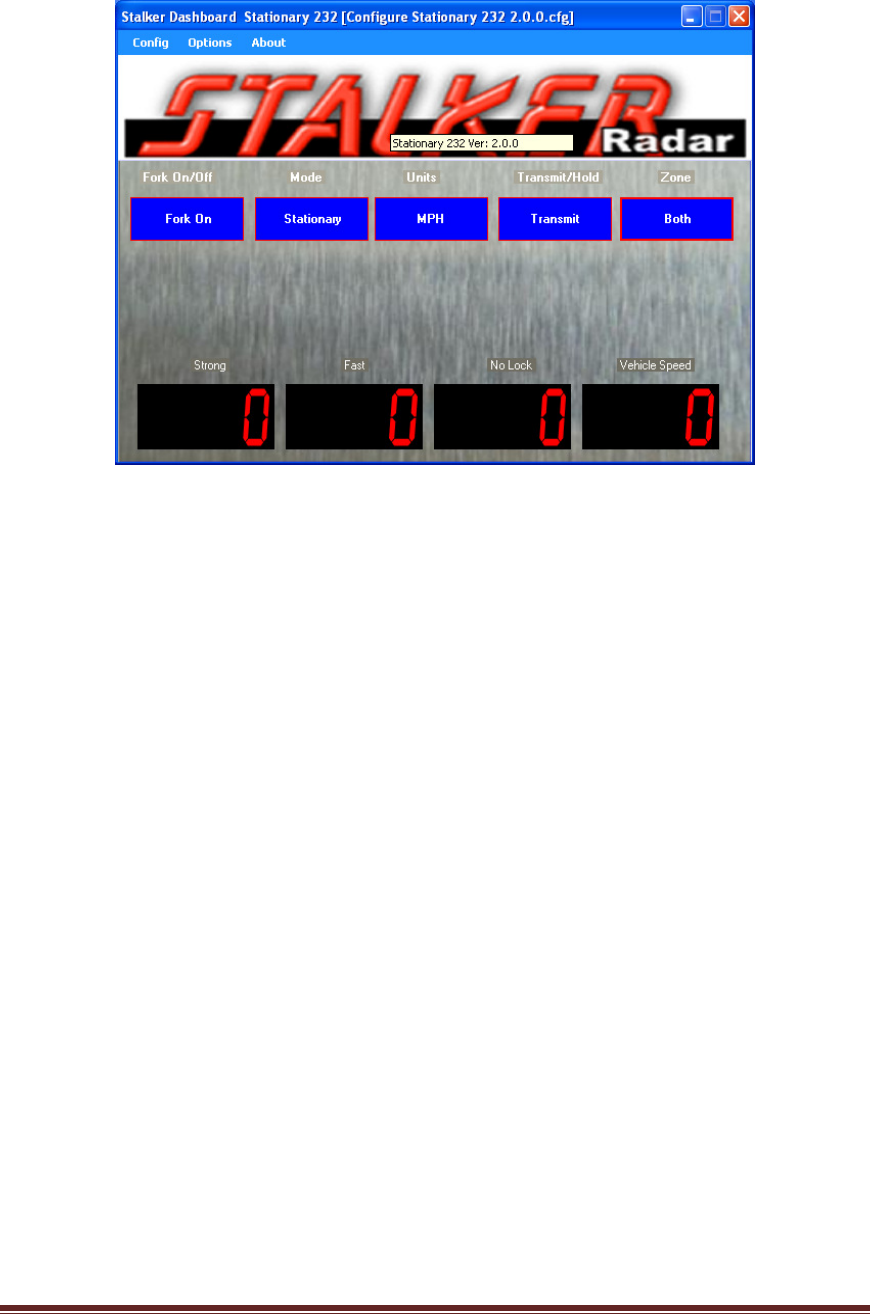
Applied Concepts 011-0131-00 rev 2 Page 33
Place the mouse pointer over the S logo and a rollover pop up message displays the
version of code loaded in the Speed Sensor (e.g. Stationary 232 Ver: 2.0.0). The
display of this version is assurance that the unit is powered and communicating since
the application must poll it to find out this information
6.5 Troubleshooting Communication Issues
If the version is blank when the Speed Sensor is polled as above, the unit is not
communicating with the PC. The problem could be a power problem with the Speed
Sensor or a communication link problem between the PC and Speed Sensor.
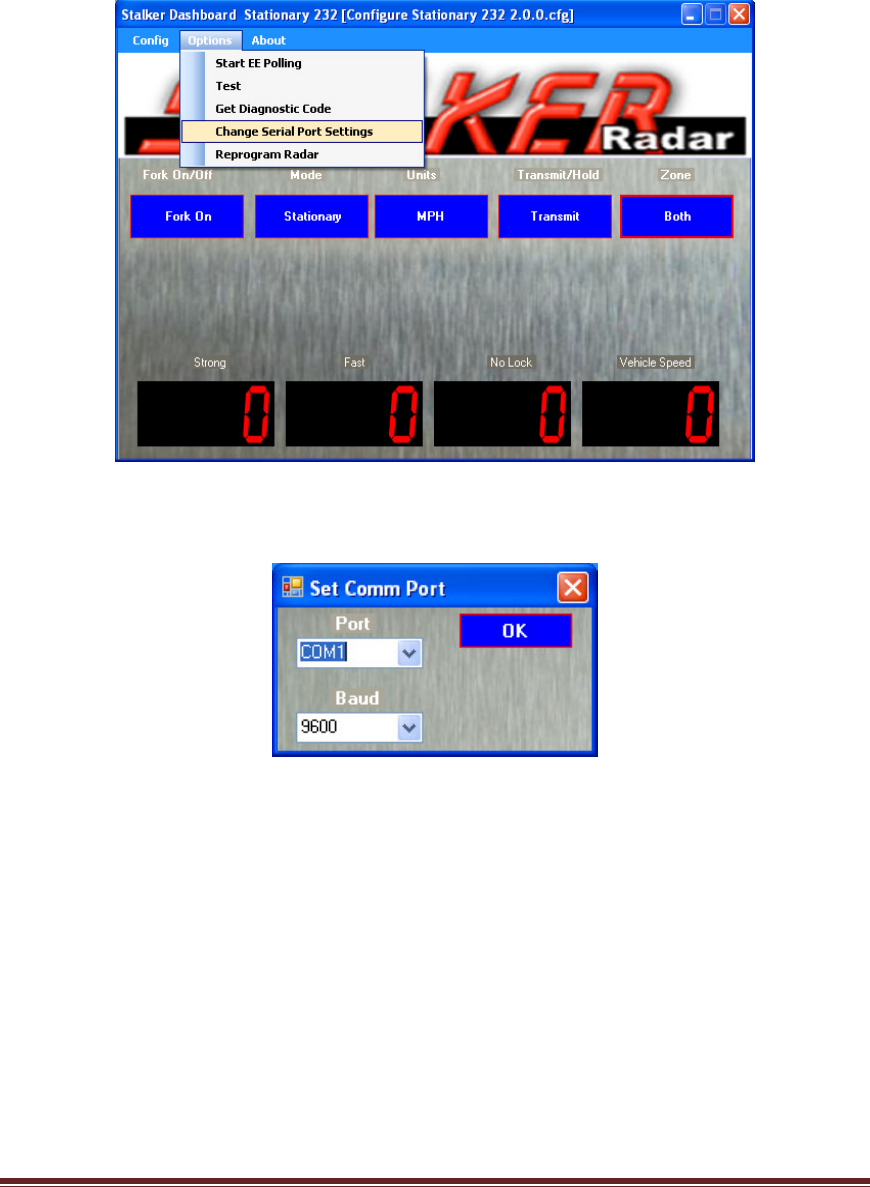
Applied Concepts 011-0131-00 rev 2 Page 34
For suspected communication link problems or to change the serial port or the baud
rate, click on “Options” in the main screen and select “Change Serial Port Settings” from
the pull-down menu.
Change the Port setting to match the PC’s serial port being used by the Dashboard
application and the Baud rate to match the baud rate setting in the Sensor.
If there is still no luck communicating with the unit, there is a way to force the Speed
Sensor to a known setting. To change it to its factory default 9600 baud setting, perform
the sequence outlined in the Factory Defaults section in the next chapter. Be careful
using this method because all of the Speed Sensor’s settings are changed back to
factory defaults – not just the baud rate. If other settings were configured for a custom
application, they will need to be set again.
For suspected power issues, check the power source and cabling. If the green LED on
the Programming Box does not turn on when the switch is turned on, the box is not
getting power. Make sure the power source is on and has a good connection to the box.
The cigarette plug has an internal fuse that can be checked. Unscrew the knurled knob
on the nose of the plug to access the fuse. Replace it with one of the same size and
ratings if it is blown.

Applied Concepts 011-0131-00 rev 2 Page 35
If the green LED does come on, power is making it to the box but maybe not to the
Speed Sensor. Unscrew the Speed Sensor Power and I/O Cable from the unit and
measure for proper voltage (9-16 VDC) between pins 2 and 5 on the cable.
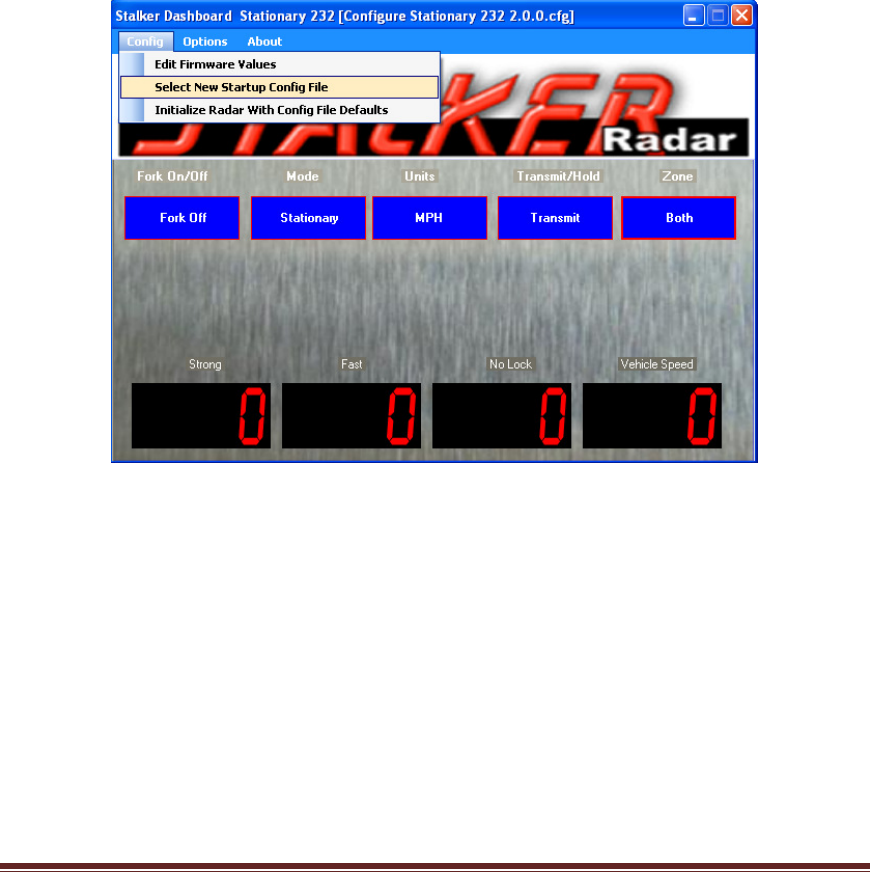
Applied Concepts 011-0131-00 rev 2 Page 36
7 Configuring the Speed Sensor
When viewing the main screen of the demo application, the name of a configuration file
is displayed in the title bar (e.g. [Configure Stationary 232 2.0.0.cfg]). This file defines all
of the configurable settings that are available on a particular model of Speed Sensor.
Since features and settings are added and changed in different versions of software, the
filename also includes the version (2.0.0) that the file’s settings apply to.
The screen-shot examples in this chapter are taken from the Stalker Dashboard
application. All of the configuration features and capabilities, except software upgrading,
are also available with the S3-Speed Sensor PC Apps located on the Program CD.
If the filename is for a different unit, open a list of other available configuration files by
selecting “Select New Startup Config File” from the Config pull-down menu.
The dialog box on the next page will open and allow for a selection to be made. It is
important that the model and software version in the configuration filename match
the model and version in the Product ID. The dialog box will contain the Sensor
model and current software revision in the blue title bar.
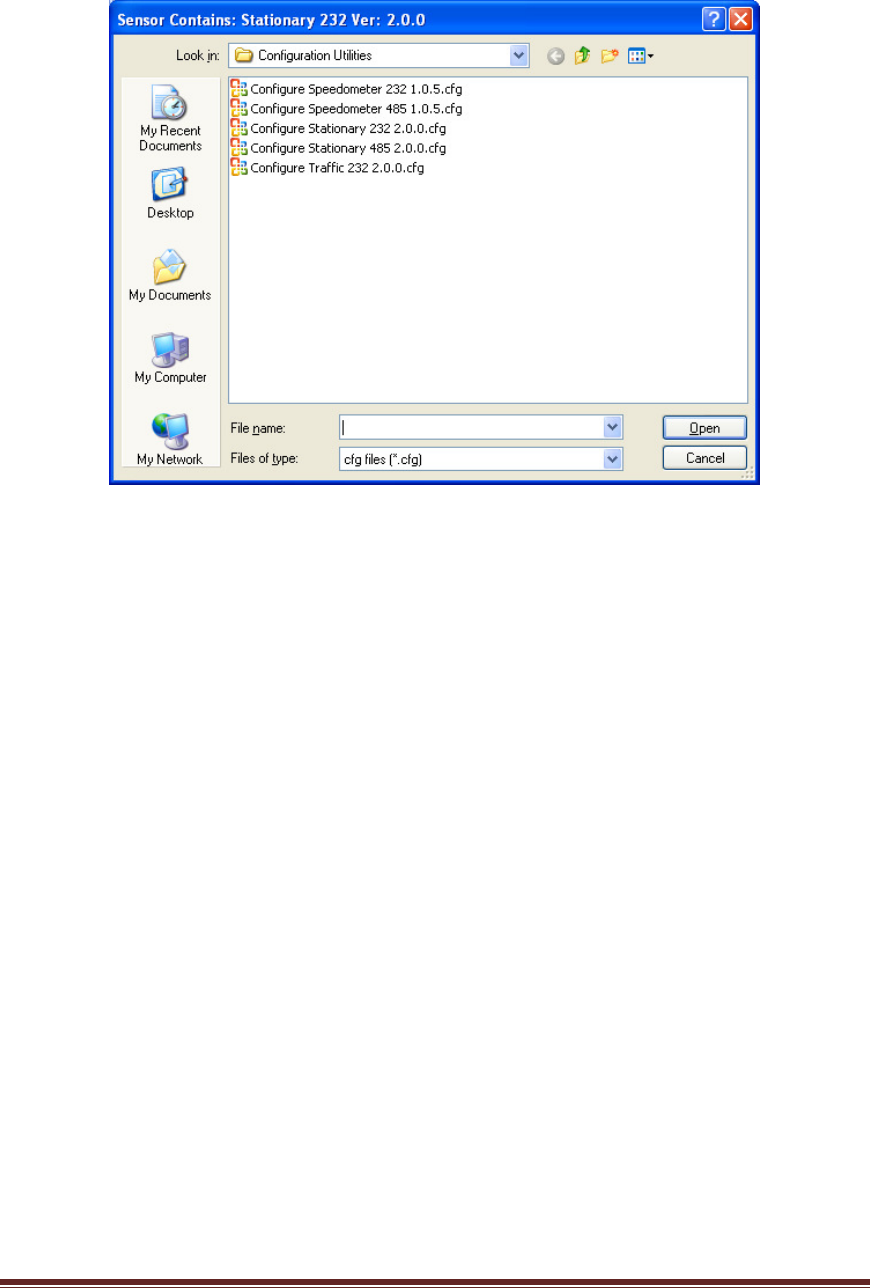
Applied Concepts 011-0131-00 rev 2 Page 37
If there are no .cfg files in the list, make sure the “Look in” window is set for the
Configuration Utilities folder under C:\Program Files\Stalker – the standard installation
location for these files. If the correct file is still unavailable, a lower version number for
that model will work, but it may not provide access to newer features. The matching
configuration file is always available from Stalker. Contact us so we can send it to you.
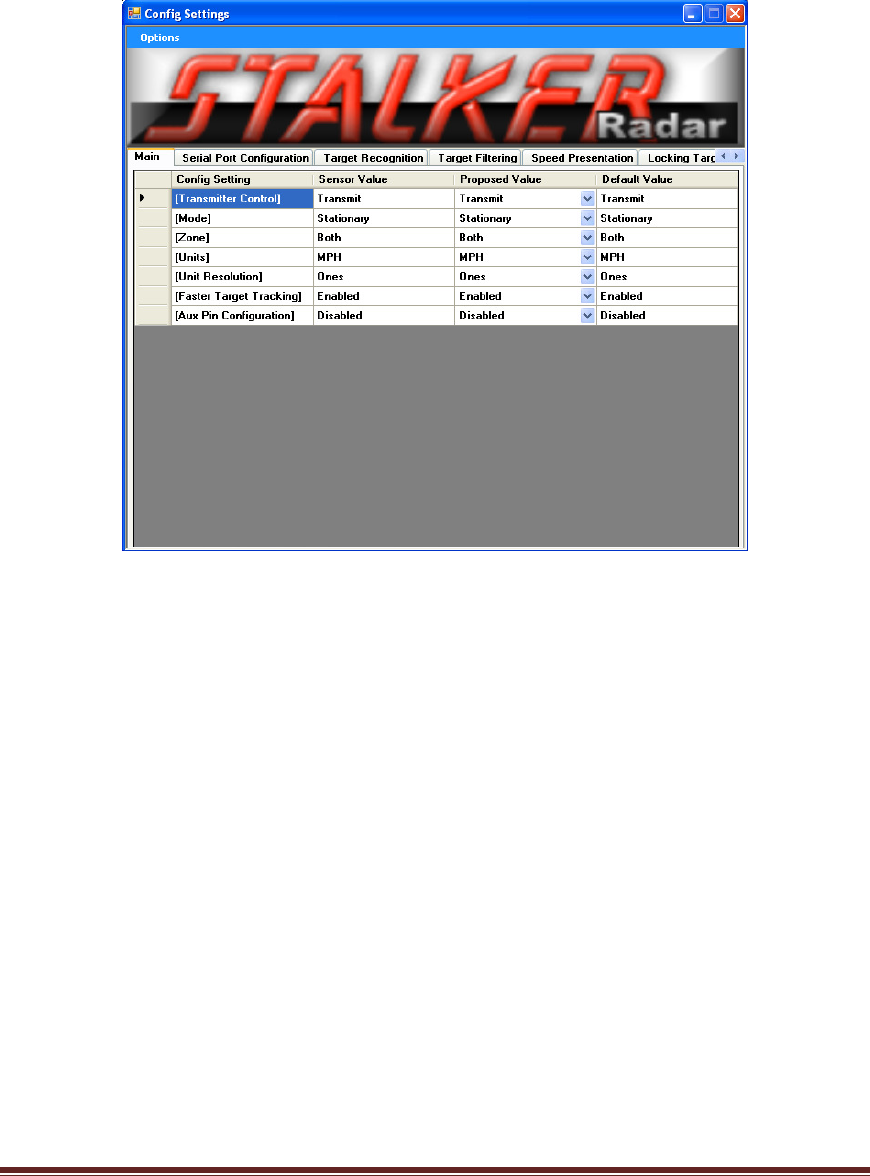
Applied Concepts 011-0131-00 rev 2 Page 38
7.1 Reading the Current Configuration
From the Config pull-down menu, select “Edit Firmware Values”. The application will
poll the Speed Sensor to read all the settings defined in the configuration file and then
display the Configuration window below.
The settings are grouped by type and the different types can be selected by clicking on
the appropriate tab. More tabs can be made visible by clicking on the left and right
arrows next to the last tab on the right.
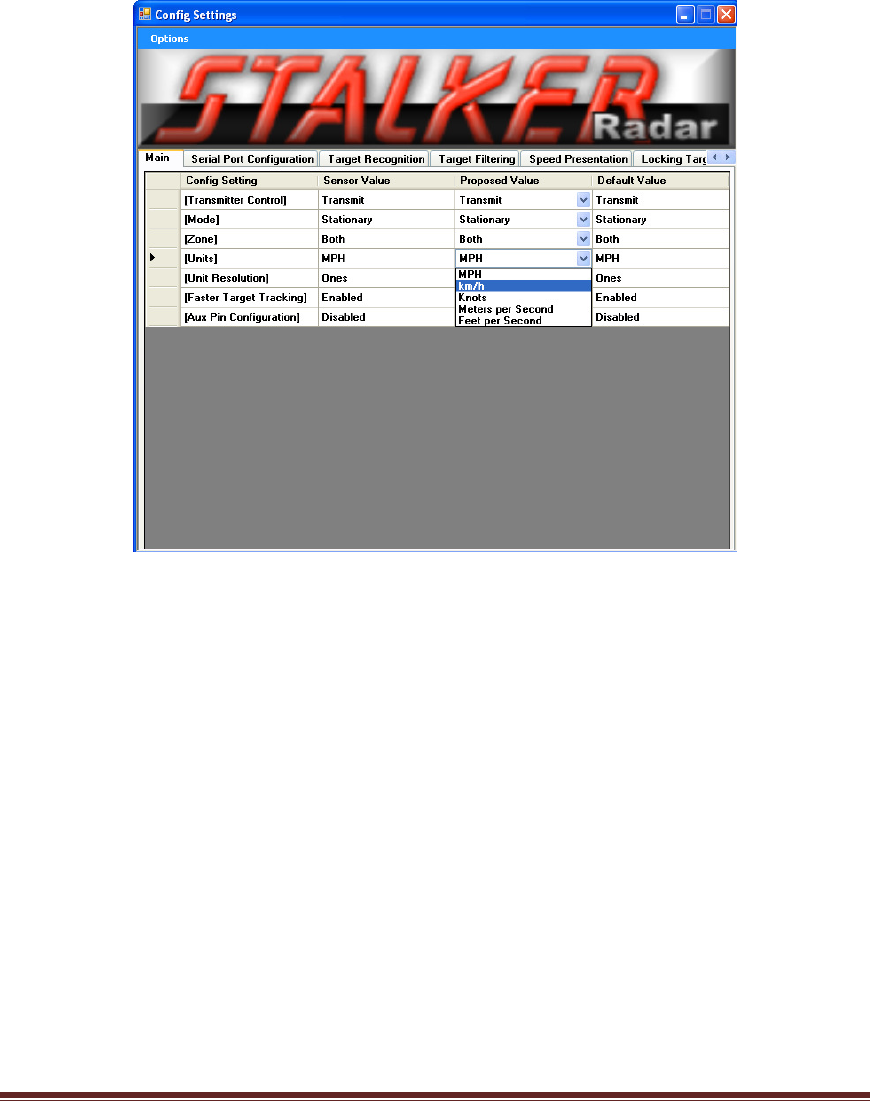
Applied Concepts 011-0131-00 rev 2 Page 39
7.2 Changing and Saving the Configuration
The settings in the Speed Sensor can be changed by selecting other values from the
settings’ pull-down menus as shown below, for example, changing the units from MPH to
km/H (Kilometers per Hour). Click the Options Menu and select the Upload Proposed
Values to Sensor to save the settings changes to the Speed Sensor. The changes can
be confirmed by observing that the Sensor Values are now equal to the Proposed
Values.
When Upload Proposed Values to Sensor button is clicked, the Stalker Dashboard
application sends separate commands to the Speed Sensor to set each value. The
Speed Sensor responds to each command with its new or current setting value. The
new settings are stored in the Speed Sensor’s internal memory and are remembered
even when the unit is turned off and back on.
If the Speed Sensor responds to the application with a value different from the desired
value, an error may be seen as shown below. This example shows many errors due to
the fact the unit was turned off.
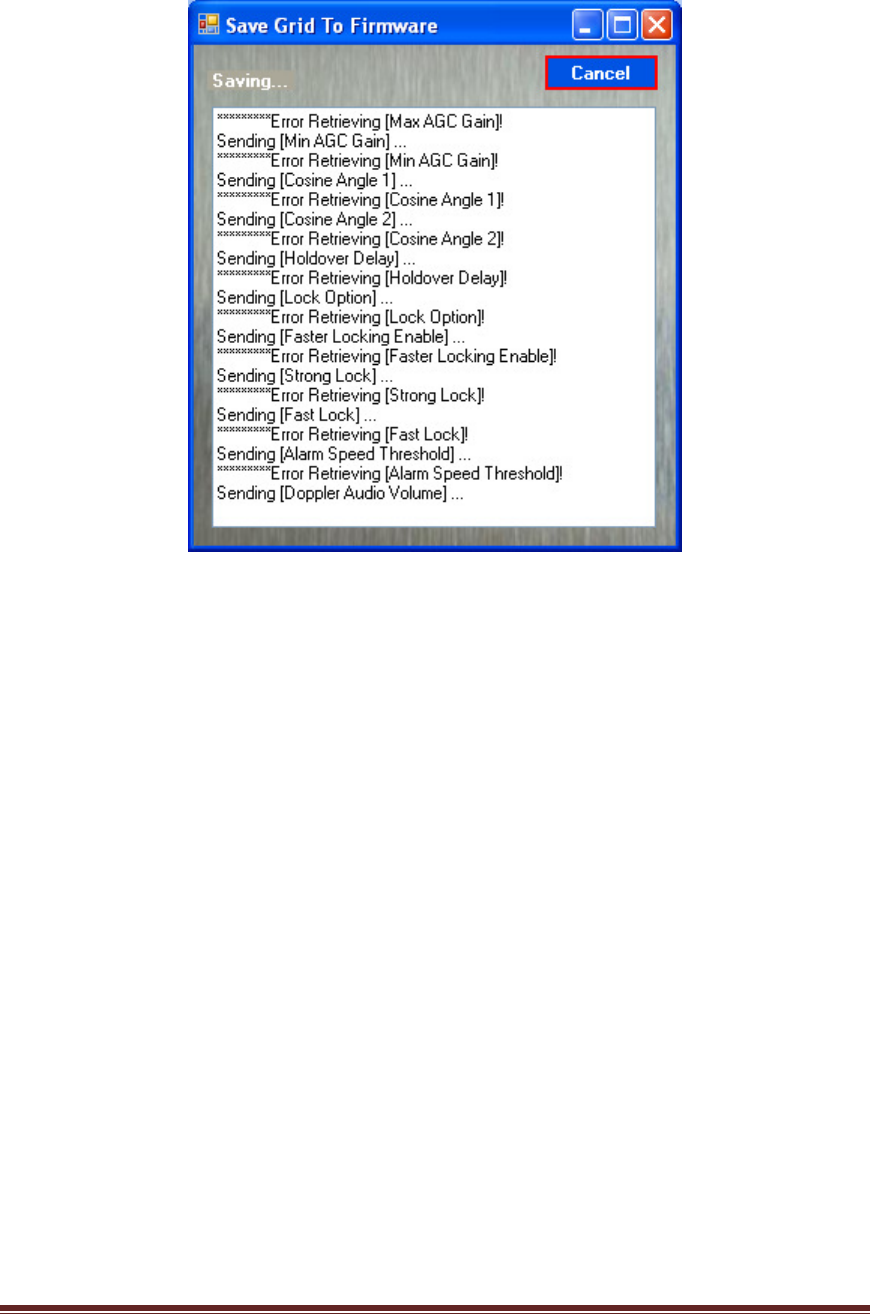
Applied Concepts 011-0131-00 rev 2 Page 40
This warning can be caused by a number of reasons.
1. If the application tries to change a setting that is not defined for a particular
model or version, the Speed Sensor returns the value “255” meaning that it does
not understand the request. Make sure the application is using the correct
configuration file and that all settings in the configuration file are applicable to
that Speed Sensor model.
2. If an illegal value is sent to the Speed Sensor, it ignores it and responds with a
legal value.
3. Some settings require the internal state machine of the Speed Sensor to run
before the setting is actually changed. The Speed Sensor can respond to the
application’s command message before the state machine has run, so the initial
response may not be the desired setting. Re-open the Configurations window
after the warning to verify that the setting did actually change.
These settings are Mode, Zone, Transmitter Control, Strong Lock, Fast Lock,
Test and Fork Enable.
4. Some settings are read-only settings, and the Speed Sensor will respond with its
internal value regardless of what value was requested. These settings are Get
Product ID and Get Current AGC Gain. Refer to the end of the Speed Sensor
Configuration File section for details on controlling warnings caused by these
settings.

Applied Concepts 011-0131-00 rev 2 Page 41
7.3 Configuration Settings
There are many Speed Sensor configuration settings. Some apply to all Speed Sensors
but others are specific to certain models. All settings for all models are described in
detail in Appendix C where they are organized in the following groups of related function:
1. Basic Configuration
2. Serial Port Configuration
3. Target Recognition
4. Target Filtering
5. Speed Presentation
6. Locking Targets
7. Speed Alarm
8. Audio
9. TX Power Save
10. Testing
11. System
In Appendix D, all settings are listed in the order of their ID number. The table there
shows all available values for each setting and the factory default value for each model
of Speed Sensor it applies to.
7.4 Changing the Baud Rate
Since the baud rate of the Speed Sensor and the baud rate of the Dashboard application
must be the same for communications to work, use the following steps to change the
baud rate.
1. Open the Config Settings grid as described above and click on the Serial Port
Configuration tab to see the serial port settings.
2. Change the baud rate to the new desired value and save the setting. At this
point the Speed Sensor and the Dashboard application are still communicating
with the previous baud rate; the baud rate of the Speed Sensor has not changed
yet.
3. Turn the Speed Sensor off and back on to complete the baud rate change in the
unit.
4. Configure the Scoreboard application’s baud rate to the new desired value as
described in Section 6.5 above. You may need to close and reopen the
application to complete the process.
7.5 Default Settings
There are two types of default values for the Speed Sensors. Factory defaults are hard-
coded into the unit and can not be modified. Configuration File defaults are saved in the
configuration files discussed above. They can be changed in the file and saved for
custom user default values.
7.5.1 Factory Defaults
The factory defaults for each setting and each product are listed in Appendix D. To
return all values to their factory defaults, perform the following sequence:
• Turn the Speed Sensor off using the switch on the Programming Box.
• Press and hold the red Reset button on the box (or ground the AUX pin) while
turning the unit back on.
• Release the red button after 2 or 3 seconds.
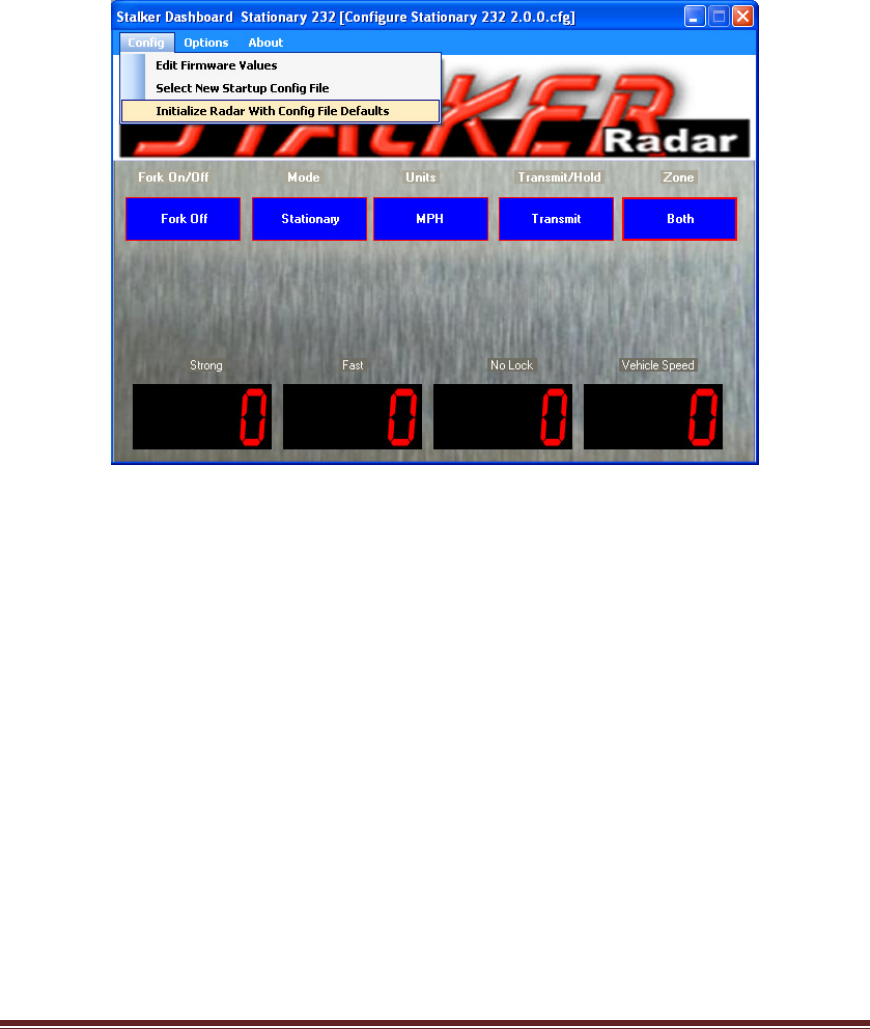
Applied Concepts 011-0131-00 rev 2 Page 42
• Turn the unit off briefly and then back on again.
Be careful using this method because all of the Speed Sensor’s settings are changed
back to factory defaults. If other settings had been configured for a custom application,
they will need to be set again.
7.5.2 Configuration File Defaults
To configure the Speed Sensor with the default values in the currently selected
configuration file, select the “Initialize Radar With Config File Defaults” from the Config
pull down menu. Make sure that the desired configuration file is selected (as described
in the beginning of Section 5) before initializing with defaults.
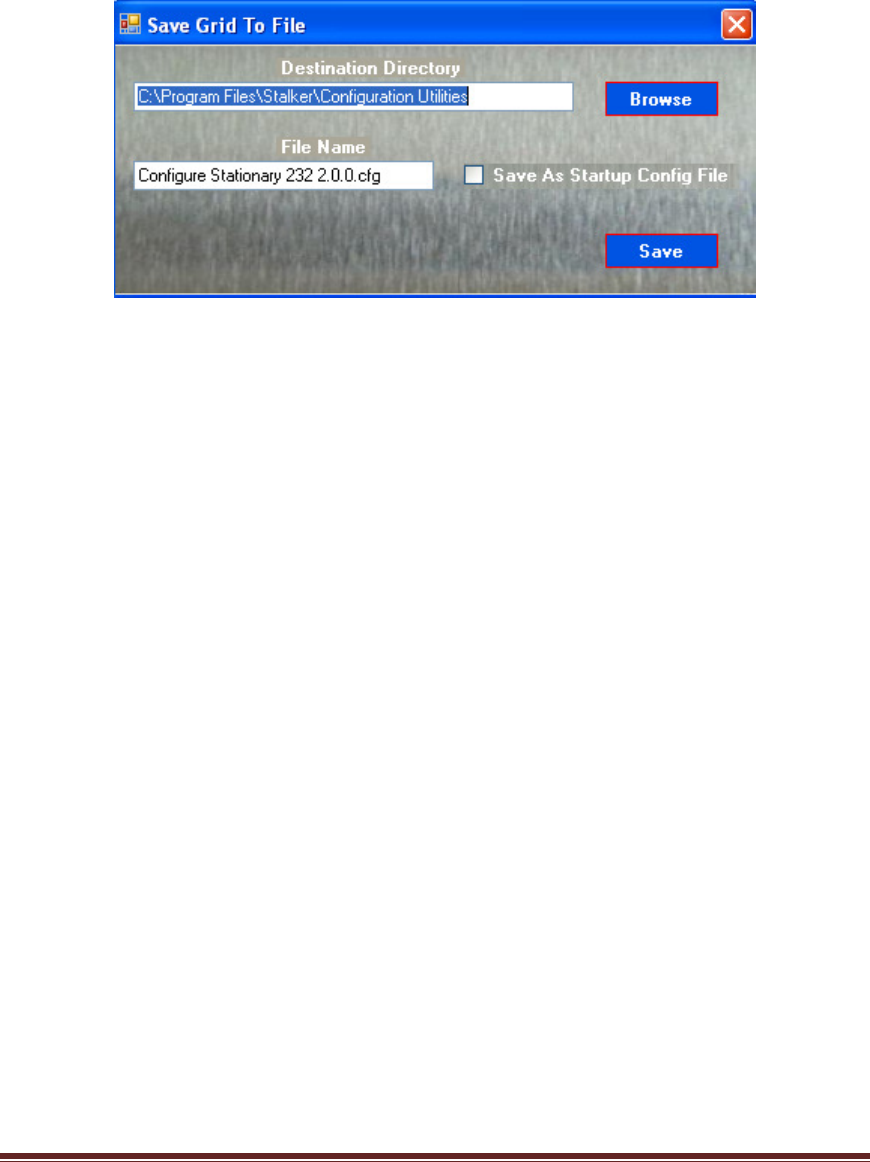
Applied Concepts 011-0131-00 rev 2 Page 43
The default values in the standard configuration files available from Stalker Radar are
equal to the factory defaults listed in Appendix D. If changes are made to values for a
custom configuration, they may be saved as default values in a new configuration file for
later use. Once all changes are made, select “Save Sensor Values To New File As
Defaults” from the Options pull-down menu.
Save the new configuration file with a name describing the custom application. The next
time “Select New Startup Config File” is selected from the Options pull-down, the new
file will be available also. If the box above is checked for “Save As Startup Config File”,
the newly created file name will appear in the title bar and that file is then used for the
configuration tasks.
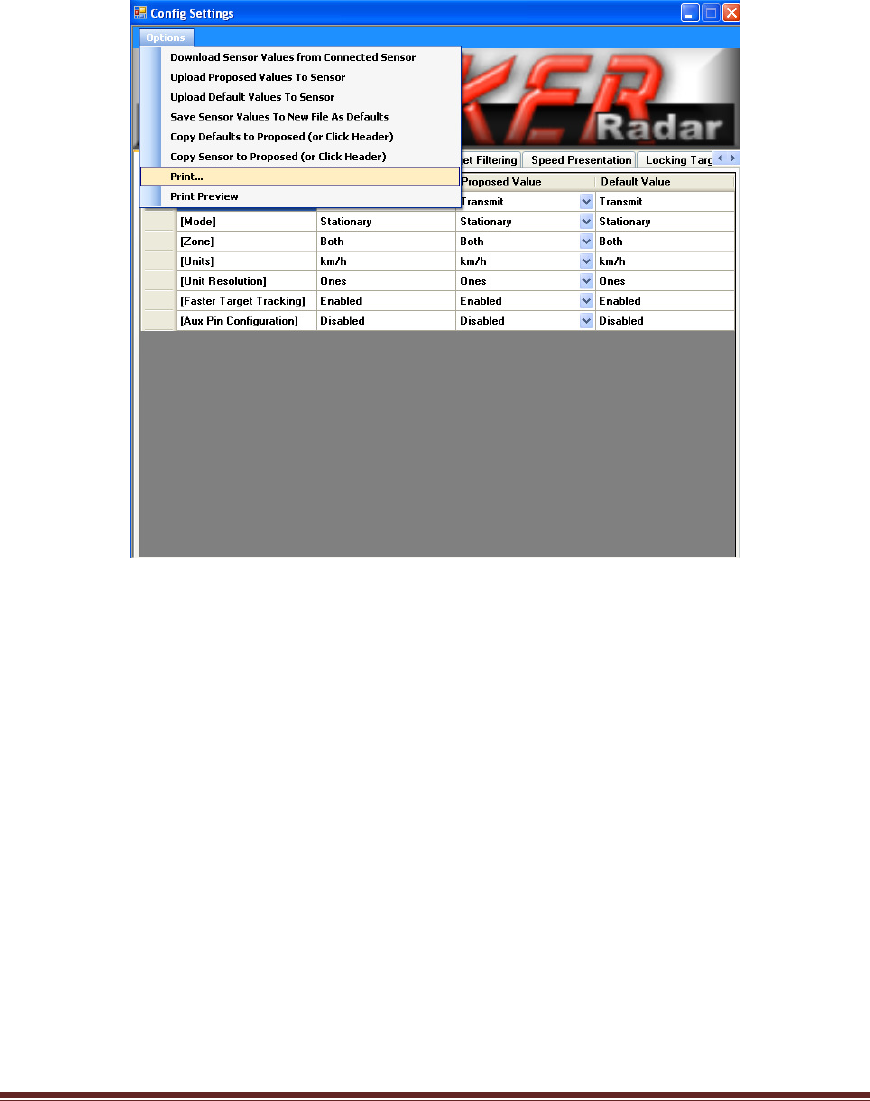
Applied Concepts 011-0131-00 rev 2 Page 44
7.6 Printing Setting Values
The current configuration settings in a Speed Sensor can easily be printed for a record
of values. A preview of the pages to be printed can be selected by clicking on “Print
Preview”. To print the pages, select “Print” from the Options pull-down menu. A Windows
Print screen will appear for you to select a printer to print the file to. Select the desired
printer or use the default printer. The table of configuration values will print with a header
at the top of each page that shows the date, Sensor type, and software version.
7.7 Fork Test
A Fork Test can be run to ensure proper operation of a Speed Sensor radar. Tuning
forks are calibrated to ring at a certain frequency that simulates a Doppler return from a
moving object. Since they are not truly directional signals and since the radar normally
filters out non-directional signals, a “fork mode” is provided to easily read tuning forks.
When the Fork Mode status on the demo application’s main screen is On, strike a fork
and hold it in front of the radar’s lens to see its calibrated speed readout in the target
window. If the speed stamped on the tuning fork matches the speed displayed, the
radar is seeing targets and reporting them properly.
Fork Mode is automatically turned on for one minute when the Speed Sensor is powered
up. This allows a quick fork test before the mode is automatically turned off and the
radar again processes only directional targets. If a longer fork period is desired, turn on
fork mode using the Fork Enable configuration setting (setting 47). When enabled in this
manner, fork mode stays on for 10 minutes before it automatically turns off again.
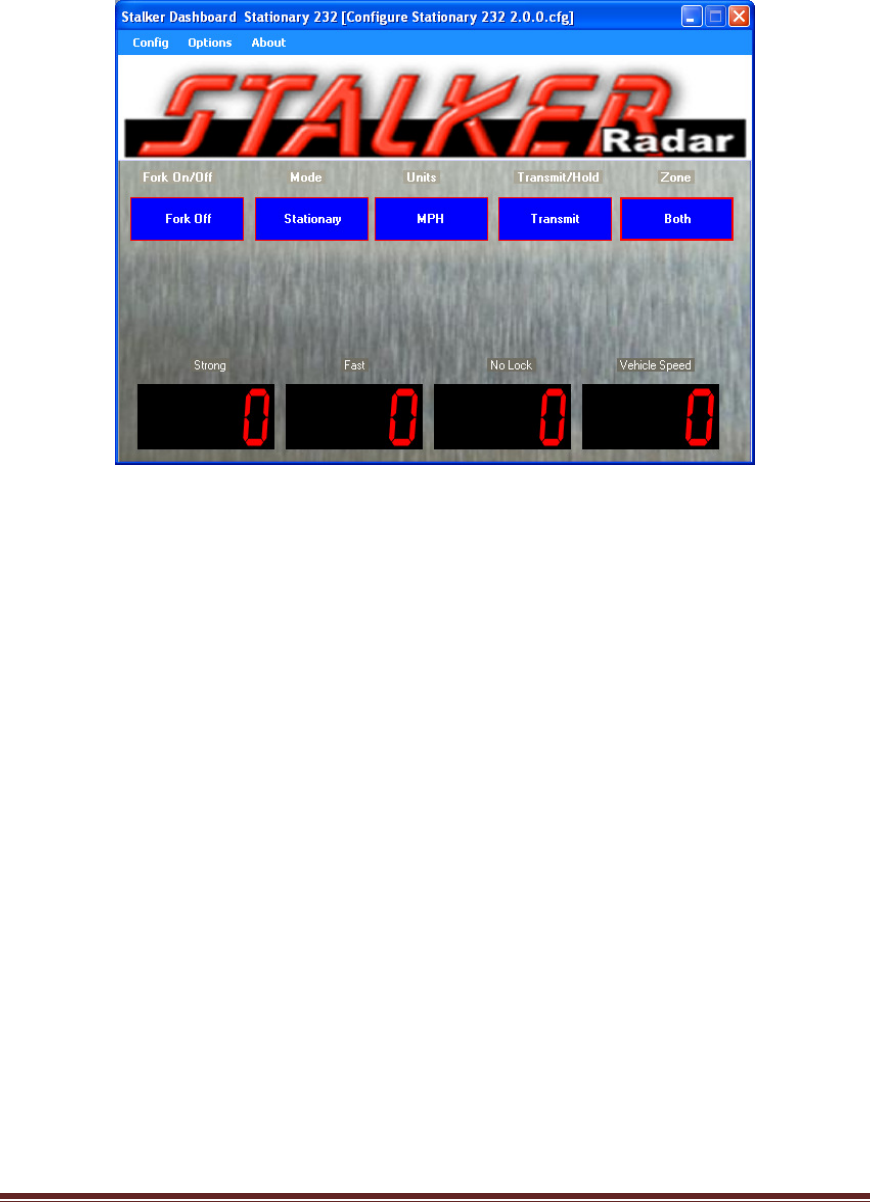
Applied Concepts 011-0131-00 rev 2 Page 45
7.8 Demo Application Soft Keys
When using the Stalker Dashboard application to communicate with the unit, several
softkeys are available for configuration and control of the unit:
Fork On/OFF – Toggles the fork mode on and off. Used when testing with a tuning fork.
Mode – clicking this button alternates the mode of the unit between Stationary and
Moving. This capability is only available in the Traffic Speed Sensor which has both
modes of operation.
Units – Selects the type of units that the Sensor will output and be displayed in the
speed windows.
Transmit/Hold – clicking this button turns on and off the radar transmitter. The status
displays as Transmit or Hold.
Zone – When in Stationary mode, clicking this button cycles through the Away, Closing
and Both zones. When in Moving mode, it alternates the zone between Same lane and
Opposite lane.
Locking Speeds – Though not shown as a soft key, a Strong target or Fast target
speed can be locked by clicking the window showing the desired speed to be locked.
The locked speed will be shown in the Lock window. To clear the locked speed, click the
Lock speed window.
7.9 Monitoring Speed Data
The radar transmitter must be on for the Speed Sensor to register speeds. The unit will
get warm to the touch when the transmitter is on for long periods, but this is normal and
no cause for alarm.
The demo PC application can be used to monitor speeds that the Speed Sensor detects.
Other equipment or applications can also monitor the speed data from the unit by
decoding the messages it transmits over the serial link.
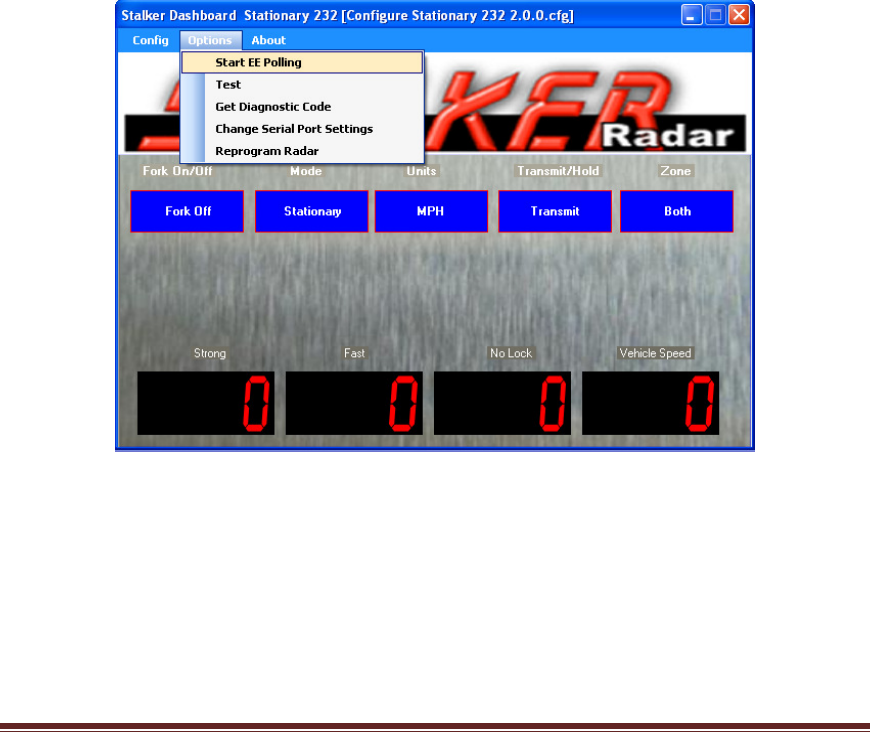
Applied Concepts 011-0131-00 rev 2 Page 46
Several message formats are available and can be selected. Refer to Appendix A and
Appendix B for the content and organization of the fields for the different formats. They
vary from simple ASCII character strings to longer formats reporting multiple speeds and
status information. There are streaming formats and polling formats.
The RS-232 models can stream data in any format except EE which is reserved as a
polling-only format. Whenever the radar transmitter is on, the Speed Sensor streams
out speed messages in the selected message format at a fixed number of messages
each second.
The RS-232 models can also communicate using the Format EE handshaking (or
polling) method. Instead of automatically streaming data out, it sends a single Format
EE speed message packet only when the controller asks for one. The Stationary Speed
Sensor reports the strong target speed value, and the Speedometer and Traffic Speed
Sensors report the vehicle speed value.
To enable Format EE polling, make sure the radar transmitter is on and that the
Message Format is configured for EE. Then select “Start EE Polling” from the Options
pull-down menu on the main screen as shown below. The Dashboard application will
then begin sending EE Format Requests and displaying the values returned from the
Speed Sensor. To stop the polling from the application, select “Stop Polling” from the
same menu.
The RS-485 models can only use handshaking methods since they are always a slave
on the link. They never send data unless the controller asks for it. They can
communicate using Format EE polling as described above, but only if the unit’s address
is 2, the factory default. Refer to Section Error! Reference source not found. for more
detail describing how to check or set the Speed Sensor address.
The Stationary RS-485 model can also use the more flexible EA polling. With this
method, the controller sends an EA request as described in Appendix B, and the Speed
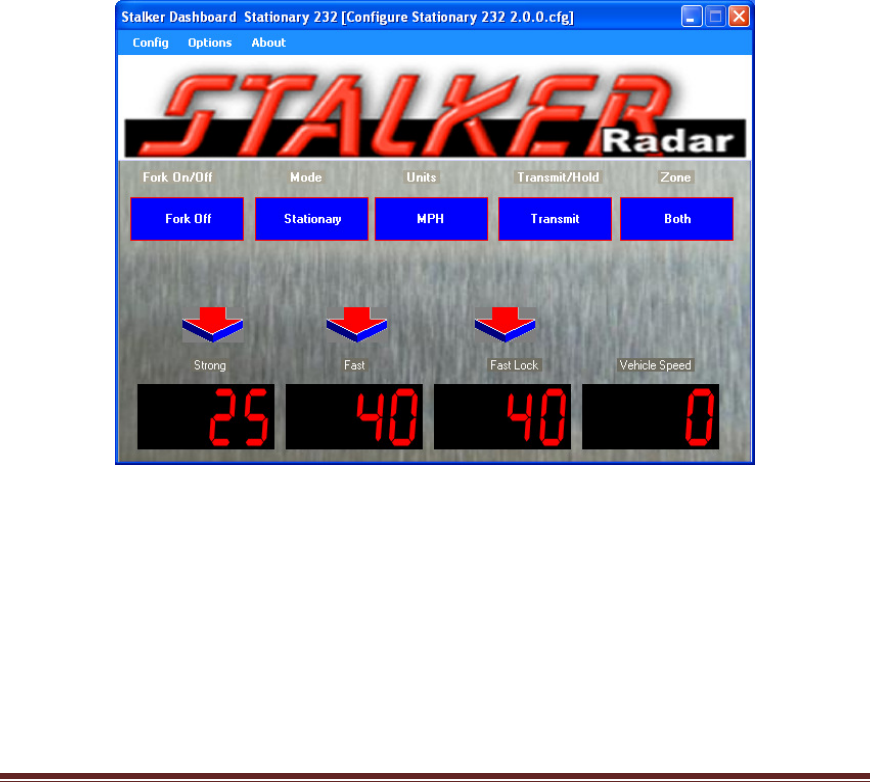
Applied Concepts 011-0131-00 rev 2 Page 47
Sensor returns a single message of whatever Serial Port Output Format is selected.
Since the EA request has address fields, the controller can poll any individual unit on a
point-to-multipoint link and get back a speed report from only that unit. The Dashboard
application does not support EA polling. A custom application as described in Section
Error! Reference source not found. is required to make use of this feature.
The Stalker Dashboard application displays the speeds it receives in the appropriate
speed windows. For a Stationary Speed Sensor, the strongest target the radar sees
shows in the STRONG window. If a faster, weaker signal is detected, it shows in the
FAST window. And if either a strong or fast target is locked, that speed shows in the
LOCK window. A Traffic Speed Sensor displays all of these speeds plus the vehicle
speed in the VEHICLE SPEED window. The Speedometer Speed Sensor only reports
vehicle speed which displays in the VEHICLE SPEED window.
In the example below, a Stationary Speed Sensor is reporting a strong target speed of
25 MPH and a faster target speed (which has been locked) of 40 MPH. Note the arrows
above the speed windows. The down arrows signify that the targets are approaching the
radar (closing speeds). Up arrows signify targets moving away (away speeds).
7.10 Logging Speed Data
When the Speed Sensor is sending speed data in the EE Format (the handshake
protocol), the Dashboard application can log the data to a file for later review. This
comma-delimited file lists each speed entry with a timestamp and can easily be imported
to a spreadsheet or text editor. Logging is not enabled by default, so a few settings in
the application’s control file are necessary to get it started. Refer to the next chapter for
complete details of this control file, but follow the steps below to enable logging:

Applied Concepts 011-0131-00 rev 2 Page 48
• Locate the file named Dashboard.ini in the “C:\Program
Files\Stalker\Dashboard\Application” folder.
• If the file is not in that location, right click on the demo application desktop
icon and select “Properties” to open the properties window for the icon. Click
on the Shortcut tab and look in the “Start in:” field for the location of the
application executable file and the Dashboard.ini file.
• Open the Dashboard.ini file in any text editor such as WordPad or Notepad.
• Find the ENABLE_SPEED_LOGGING line and ensure the parameter is set =1.
• If logging of zero speeds is desired, set the LOG_ALL_SPEED_DATA parameter
=1. If only non-zero speeds are desired, set it =0.
• Type in the desired name of the log file after the DATA_LOG_FILE parameter.
The default is Speed Log.csv. The log file will be created in the same folder as
the application executable and Dashboard.ini files.
• Set the polling interval with the EE_FORMAT_INTERVAL parameter. The
number represents milliseconds between polls, and the default value is 100 ms
(ten times per second).
To initiate logging, make sure the radar transmitter is on and that the Serial Port Output
Format is configured for EE. Then select “Start EE Polling” in the Actions pull-down
menu. To stop logging, select “Stop EE Polling”. The demo application appends new
data to the log each time the EE Format is started.
8 Configuring the Stalker Dashboard Application
The Stalker Dashboard application for communicating with and configuring Speed
Sensors consists of a set of files which reside on the PC. The Developer’s Kit CD
provided with the Speed Sensor Programming Box Kits installs all of the files listed
below (in italics) on the user’s PC under the C:\Program Files\Stalker folder.
Stalker Dashboard.exe is the PC demo application executable file used to control and
communicate with the Speed Sensors.
Dashboard.ini is the control file for the demo application.
These two files are installed in the C:\Program Files\Stalker\Dashboard\Application
folder.
The executable file and the Dashboard.ini control file are used as a pair when the
application is running. The executable file reads parameters from the control file during
initialization. And the executable file also updates the control file during operation. For
this reason, only one executable file in a folder should be run at a time. If more than one
executable is running and trying to use the same Dashboard.ini file, the executables will
interfere with each other.
It is possible to run more than one application at a time on one PC if, for example, there
is another Speed Sensor connected to different serial port. Simply copy the executable
file and the Dashboard.ini file to a different folder where they can run without
interference.
There are also unique standard configuration files for each model and software version
of Speed Sensor:

Applied Concepts 011-0131-00 rev 2 Page 49
Configure Traffic 232 x.x.x.cfg is for a Traffic Speed Sensor version x.x.x.
Configure Stationary 232 x.x.x.cfg is for an RS-232 Stationary Speed Sensor.
Configure Stationary 485 x.x.x.cfg is for an RS-485 Stationary Speed Sensor.
Configure Speedometer 232 x.x.x.cfg is for an RS-232 Speedometer Speed Sensor.
Configure Speedometer 485 x.x.x.cfg is for an RS-485 Speedometer Speed Sensor.
These files are installed in the C:\Program Files\Stalker\Configuration Utilities folder.
Application Control File
The control file, Dashboard.ini, is an ASCII text file that may be edited with any text
editor such as WordPad or Notepad. It has several control parameters that can be
changed to affect the operation of the Speed Sensor application. See a copy of the file
below with explanations of the parameters following.
[Stalker]
PORT=COM1
BAUD=9600
SOURCE_ID=1
DESTINATION_ID=2
CONFIG_FILE=C:\Program Files\Stalker\Configuration Utilities\Configure Stationary 232 2.0.0.cfg
CONFIG_FILE_LOCATION=C:\Program Files\Stalker\Configuration Utilities
GET_CFG_INTERVAL=5000
RESPONSE_TIMEOUT=500
RETRY=2
EE_FORMAT_INTERVAL=100
ENABLE_SPEED_LOGGING=1
LOG_ALL_SPEED_DATA=0
DATA_LOG_FILE=Speed Log.csv
PORT defines the PC serial port used for communication with the Speed Sensor. When
the serial port is changed using the Options pull-down “Change Serial Port Settings”
function, this parameter in the Dashboard.ini file is automatically changed. It can also be
changed by editing the file. After the COM port is changed, the application needs to be
closed and re-opened for the newly selected port to be used.
BAUD defines the baud rate to be used for communication with the Speed Sensor. As
with PORT above, this parameter can also be changed via the Options pull-down
“Change Serial Port Settings” function or by editing the file. And after changing the baud
rate, the application needs to be closed and re-opened for the setting to take effect.
SOURCE_ID is always set to 1 and DESTINATION_ID is always set to 2. When
communicating with a Speed Sensor, the application is always the master of the link (ID
1) and the Speed Sensor is always the slave (ID 2). Do not change these values.
CONFIG_FILE defines the Speed Sensor configuration file used during a session, and
CONFIG_FILE_LOCATION defines the path to that file. These parameters are updated
by the application when “Select New Startup Config File” is selected from the Config
pull-down menu. The content of configuration files is discussed in detail in the next
section.

Applied Concepts 011-0131-00 rev 2 Page 50
GET_CFG_INTERVAL defines how often (in milliseconds) the application polls the
Speed Sensor to update the status fields in the main window. This parameter applies to
the status fields only (Units, Mode, Zone…) – not the speed windows. The default is
5000 ms (5 seconds). This parameter value can be increased to reduce the message
traffic on the link.
RESPONSE_TIMEOUT is the time in milliseconds that the application will wait for a
response from the Speed Sensor before a retry or failure. The default is 500 ms (½
second).
RETRY defines the number of times the application will resend a configuration setting to
the Speed Sensor if it doesn’t get a response.
EE_FORMAT_INTERVAL defines how often (in milliseconds) the application polls the
Speed Sensor for a speed report in EE Format. Polling begins after selecting “Start EE
Polling” from the Actions pull-down menu, and polling stops after selecting “Stop EE
Polling”. The default value is 100 ms (1/10 second or 10 times per second). The value
can be increased or decreased to speed up or slow down the rate of EE Format polling.
ENABLE_SPEED_LOGGING defines whether a speed log file is generated for the
current session. Logging is enabled when the parameter is set =1 and disabled when
set =0. Logging only takes place if the Speed Sensor’s Serial Port Data Format is set for
EE Format.
LOG_ALL_SPEED_DATA is used to inhibit logging 0 speeds. When set =1 all speeds
are logged including 0 speeds. When set =0 only speeds above 0 are logged, and the
length of the log file is reduced.
DATA_LOG_FILE defines the filename for the speed log. This file will be saved in the
directory where the application file and the Dashboard.ini file reside.
8.1 Speed Sensor Configuration File
The Speed Sensor configuration files are also ASCII files which can be edited with a text
editor. Stalker Radar provides a different file for each different model of Speed Sensor
and for each different software version for each model. These standard configuration
files define the settings from Appendix D that the application can control in a unit. A
short portion of a configuration file is shown below. Note that the file is organized in a
series of text blocks: three blocks in the example below.
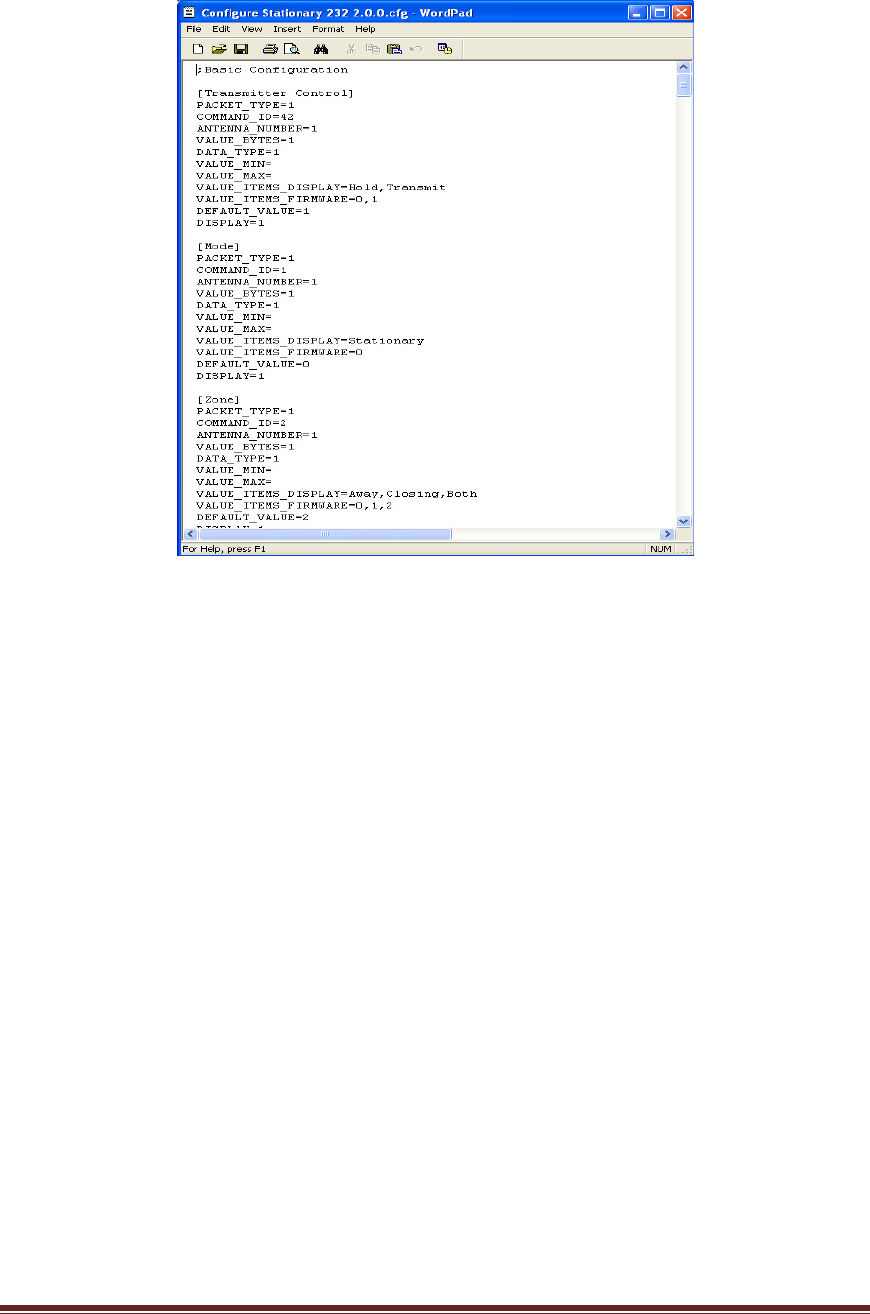
Applied Concepts 011-0131-00 rev 2 Page 51
The order of the blocks in the .cfg file determines the order in which the settings and
their values will be displayed in the Configuration window. As long as the blocks are
moved as units, they can be arranged in any order.
Blocks for the settings used most often could be placed at the top of the section so their
values appear at the top of the Configurations window. Blocks for settings that are never
used could even be deleted from the file to speed up the “Edit Firmware Values”
process. We recommend copying the standard file provided by Stalker Radar to a file
with a new name before making changes. In that way, many custom configuration files
can be created for different uses, and the standard file is always available to fall back on
for complete control.
Each block represents a different configuration setting and has the following format:
[Transmitter Control]
PACKET_TYPE=1
COMMAND_ID=42
ANTENNA_NUMBER=1
VALUE_BYTES=1
DATA_TYPE=1
VALUE_MIN=
VALUE_MAX=
VALUE_ITEMS_DISPLAY=Hold,Transmit
VALUE_ITEMS_FIRMWARE=0,1
DEFAULT_VALUE=1
DISPLAY=1
The first line in the block defines the name of the setting in brackets. This is the setting
description that displays in the left column of the Configurations screen, and it can be
changed to any name desired.
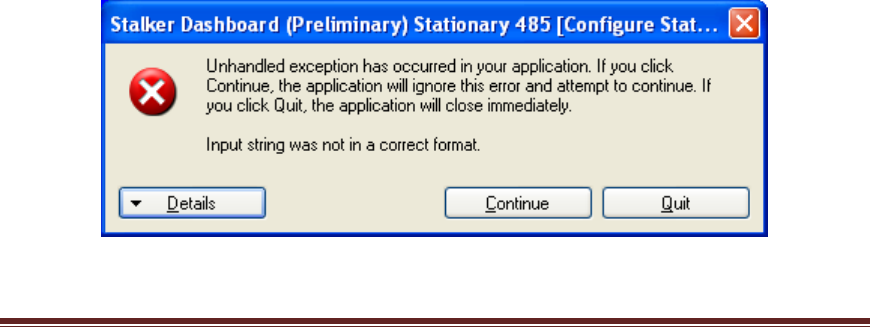
Applied Concepts 011-0131-00 rev 2 Page 52
PACKET_TYPE should be set =1. Do not change this value. It is used in the Packet
Type field of the Configuration Protocol described in Appendix E when the application is
building commands to send to the Speed Sensor.
COMMAND_ID is the Setting ID (in decimal format) from Appendix D that corresponds
to the setting description.
ANTENNA_NUMBER should be set =1. Do not change this value. It is used in the
Antenna Number field of the Configuration Protocol described in Appendix E when the
application is building commands to send to the Speed Sensor.
VALUE_BYTES is the number of bytes that the setting value uses. Do not change this
value from the value provided in the standard configuration files from Stalker Radar.
DATA_TYPE controls the behavior of the value fields. When set = 1 (list type), only the
values listed in VALUE_ITEMS_DISPLAY are valid. When set = 2 (free-form numeric
type), in addition to the values in the list (if any), the user can also enter any numeric
value in the range from VALUE_MIN through VALUE_MAX.
VALUE_MIN defines the minimum acceptable value when DATA_TYPE=2.
VALUE_MAX defines the maximum acceptable value when DATA_TYPE=2.
VALUE_ITEMS_DISPLAY defines the text that will appear as pull-down selections in
the row for a given setting in the Configurations window. The values are separated by
commas with no spaces and may be set to any desired text.
VALUE_ITEMS_FIRMWARE defines the actual values the application uses to
communicate with the Speed Sensor. These values are also separated by commas, and
the order correlates on a one to one basis with the order of the list for
VALUE_ITEMS_DISPLAY. The available values for each setting are defined in
Appendices C and D.
DEFAULT_VALUE is the default value described in the Configuration File Defaults
section. It may be set to any legal value for the setting – either from the
VALUE_ITEMS_FIRMWARE list or between VALUE_MIN and VALUE_MAX.
DISPLAY defines whether the setting is displayed in the Configurations screen. When
set =1, the setting is displayed. When set =0, the setting is not displayed. This method
can be used to skip displaying settings of no interest without having to delete the whole
block from the file.
For most commands, the Speed Sensor is able to change the setting and report the
new, desired value. However, some settings are only used for polling or monitoring the
status of the unit and cannot actually change the setting in the unit. For these read-only
settings, the Speed Sensor still sends a response, but it responds with the internal
setting value and may result in the application program displaying the following screen.

Applied Concepts 011-0131-00 rev 2 Page 53
These settings are #37 Get Product ID and #50 Get Current AGC Gain. Ensure that the
DISPLAY parameter for these settings = 0 so that the application will not try to change
them and generate a warning. Choose Continue to finish the operation but make the
necessary change to the configuration file to prevent the warning from appearing again.

Applied Concepts 011-0131-00 rev 2 Page 54
8.2 Software updates
The Dashboard program has the unique ability of uploading new software to Speed
Sensors with version 2.0.0 or later code already installed. If your Speed Sensor has
software that is earlier than 2.0.0, other PC Applications located on the Program CD can
be used for communicating to the Speed Sensor. Check with the factory to determine if
version 2.0.0 is available for your type of Speed Sensor. If software version 2.0.0 is
available, the Sensor can also be sent to the factory for upgrading to the latest program.
This section details the process of uploading a new software program to your Speed
Sensor
8.3 Checking for a new version of software
Contact the Customer Service Department at Stalker Radar and inquire about a new
version of software. Please have your current version available when asked so it can be
determined if there is a new load for your Sensor. A new version can be sent by email
and will install on your hard drive under C:\Program Files\Stalker\.... in a sub folder that
groups the different versions together.
8.4 Dashboard Setup
Once the new code has been saved to your hard disk, open the Dashboard program.
Click on the “Options” menu and then click on “Reprogram Radar”. A new window will
appear as seen below. Follow the instructions to determine which type of Sensor you
have. Click on the appropriate selection box for your radar in the upper right corner of
the screen. Click on “OK” to proceed.
Another window will open to show the available files that can be uploaded to the sensor.
Select the program that is to be uploaded to the unit, in this case “s3_sta_200.p” located
under the Stalker S3 Stationary section, see picture below. In this example, this
program is the latest version available for the Stationary type of Sensor. The folder
structure may vary by system. Double click on the icon of the desired version and click
on “Ok” on the popup window. The program will start to upload the code and a progress
meter will show at the bottom of the window. Programs for the RS485 versions of the
Speed Sensor will have the number “4” in the filename just before the revision number,
e.g. “s3_sta4_200.p”.
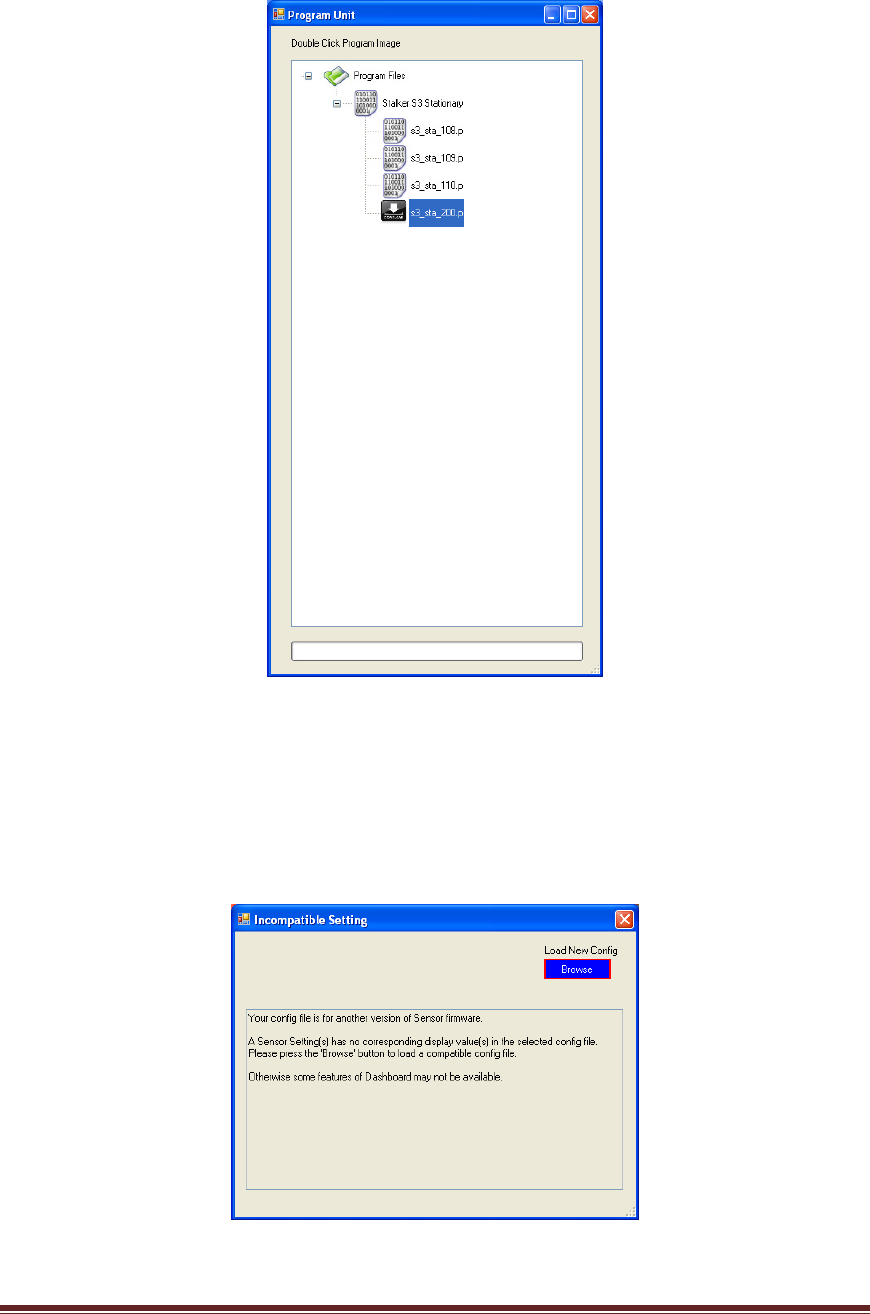
Applied Concepts 011-0131-00 rev 2 Page 55
When the upload is complete, another popup window will appear to announce a
successful upload.
One of the other types of Sensors, Speedometer or Traffic, may be installed in the
Sensor as well but the proper configuration file will need to be applied for proper
operation. If the configuration is incorrect for the program just uploaded, a warning
screen will appear and allow you to browse for an appropriate configuration.

Applied Concepts 011-0131-00 rev 2 Page 56
8.5 Accessories
9 Communication Protocols
Refer to the chapter on Custom Applications to Control Speed Sensors for details on
using this protocol to control Speed Sensors.
Configuration Protocol
Configuration packet format
# Description Value
1 Start ID 0xEF
2 Destination ID 2 – 254 (0x02 – 0xFE) For broadcast: 255 (0xFF)
3 Source ID 0x01
4 Packet Type Reserved (use 0x00 or 0x01)
5 Payload Length (LSB) The Payload Length is a 2-byte word which is the
number of bytes starting with byte #7 through and
including the last byte before the checksum bytes.
6 Payload Length (MSB) (see above)
7 Command ID Get method: Value = Setting ID in hex (and byte #9 =
0x00): causes the Speed Sensor to return the current
setting
Change method: Value = Setting ID in hex (and byte
#9 = 0x01): causes the Speed Sensor to select the
next possible setting
Set method: Value = Setting ID in hex + 0x80:
causes the Speed Sensor to use the value in byte #9
as the new configuration setting
8 Antenna Number Reserved (use 0x00 or 0x01)
9 Configuration Value Get method: Value = 0x00
Change method: Value = 0x01
Set method: Value = new desired value in hex (for
multi-byte values, the LSB is first and is followed by
the more significant bytes in low to high order)
10
Checksum (LSB) The checksum should equal the 16-bit sum of pairs of
bytes in LSB, MSB order starting with byte #1 as the
first LSB through and including the last byte before
the Checksum (in this case, byte #9). In the case of
an odd number of bytes, 0x00 is used as the last MSB
value. (See example below.)
11
Checksum (MSB) (see above)
The following is an example showing a command to set UNITS to km/h.
# Description Value
1 Start ID 0xEF
2 Destination ID 0x02
3 Source ID 0x01
4 Packet Type 0x00
5 Payload Length (LSB) 0x03 (length = 0x0003 = 3 bytes)

Applied Concepts 011-0131-00 rev 2 Page 57
6 Payload Length (MSB) 0x00
7 Command ID 0x94 = 0x14 (Setting 20) + 0x80 (set method)
8 Antenna Number 0x00
9 Configuration Value 0x01 (km/h)
10
Checksum (LSB) 0x88
11
Checksum (MSB) 0x03
Checksum = 0x0388 (truncated to the low order 2 bytes) = 0x02EF + 0x0001 + 0x0003 +
0x0094 + 0x0001

Applied Concepts 011-0131-00 rev 2 Page 59
9.1.1.1.1.1.1 Streaming Speed Data Protocols
When a streaming protocol is selected on an RS-232 model, the Speed Sensor sends
continuous speed updates in the selected output format at a specified message period.
When one of these protocols is selected on the Stationary RS-485 model, the unit sends
only a single message in the selected output format in response to each EA Poll from
the controller.
Refer to the Serial Port Configuration section in Appendix C for settings that affect the
content and timing of these messages.
The following streaming protocol message formats are supported but not necessarily by
all models. Refer to the protocol definition tables below and the Serial Port
Configuration section in Appendix C for details.
A – ASCII strong target speed only
AF – ASCII fast target speed only
B – ASCII all speeds + status
D0 – ASCII strong target speed only, optional direction byte
D1 – ASCII strong target speed only, optional direction byte, checksum
D2 – ASCII strong target speed only, optional direction byte, tenths
D3 – ASCII strong target speed only, optional direction byte, relative amplitude, tenths
D4 – HEX strong target speed only
Enhanced Output – Hex all speeds + status
S – ASCII target speeds + status
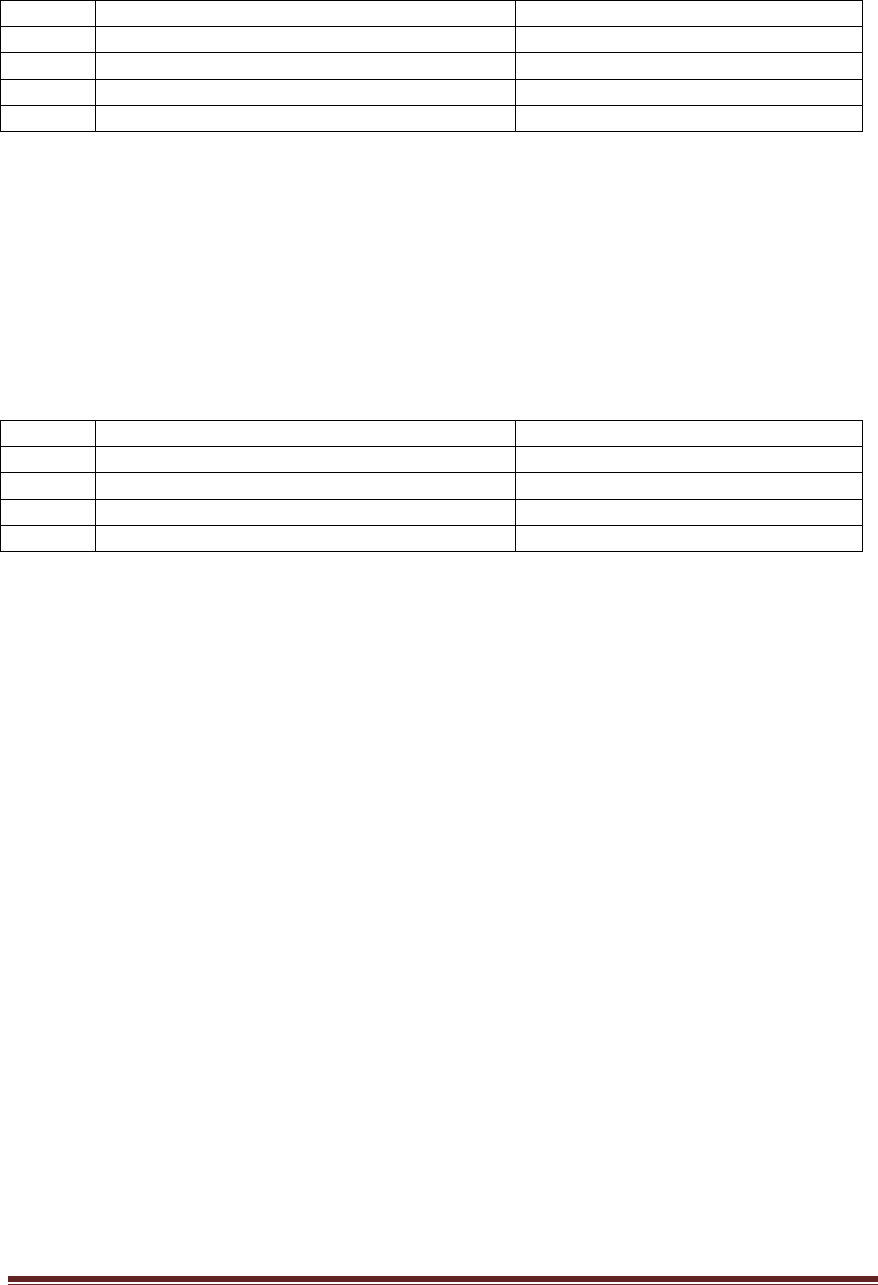
Applied Concepts 011-0131-00 rev 2 Page 60
A Format – Strong Target Speed Only
Byte # Description Value
1 Target speed hundreds digit (ASCII)
2 Target speed tens digit (ASCII)
3 Target speed ones digit (ASCII)
4 Carriage Return 0x0D
The A Format is available on the Stationary and Traffic Speed Sensor models.
A Format messages are 4 bytes in length. The baud rate setting must be 1200 or greater to
ensure that a complete message is sent before the radar processes a new message to send.
When the Unit Resolution (Setting 21) is set for tenths, the speed reported is multiplied by ten:
58.5 MPH is reported as 585. The decimal point is assumed. An A Format message can carry a
maximum speed in tenths of 99.9.
AF Format – Fast Target Speed Only
Byte # Description Value
1 Fast speed hundreds digit (ASCII)
2 Fast speed tens digit (ASCII)
3 Fast speed ones digit (ASCII)
4 Carriage Return 0x0D
The AF Format is available on the Stationary and Traffic Speed Sensor models.
AF Format messages are 4 bytes in length. The baud rate setting must be 1200 or greater to
ensure that a complete message is sent before the radar processes a new message to send.
When the Unit Resolution (Setting 21) is set for tenths, the speed reported is multiplied by ten:
58.5 MPH is reported as 585. The decimal point is assumed. An AF Format message can carry
a maximum speed in tenths of 99.9.
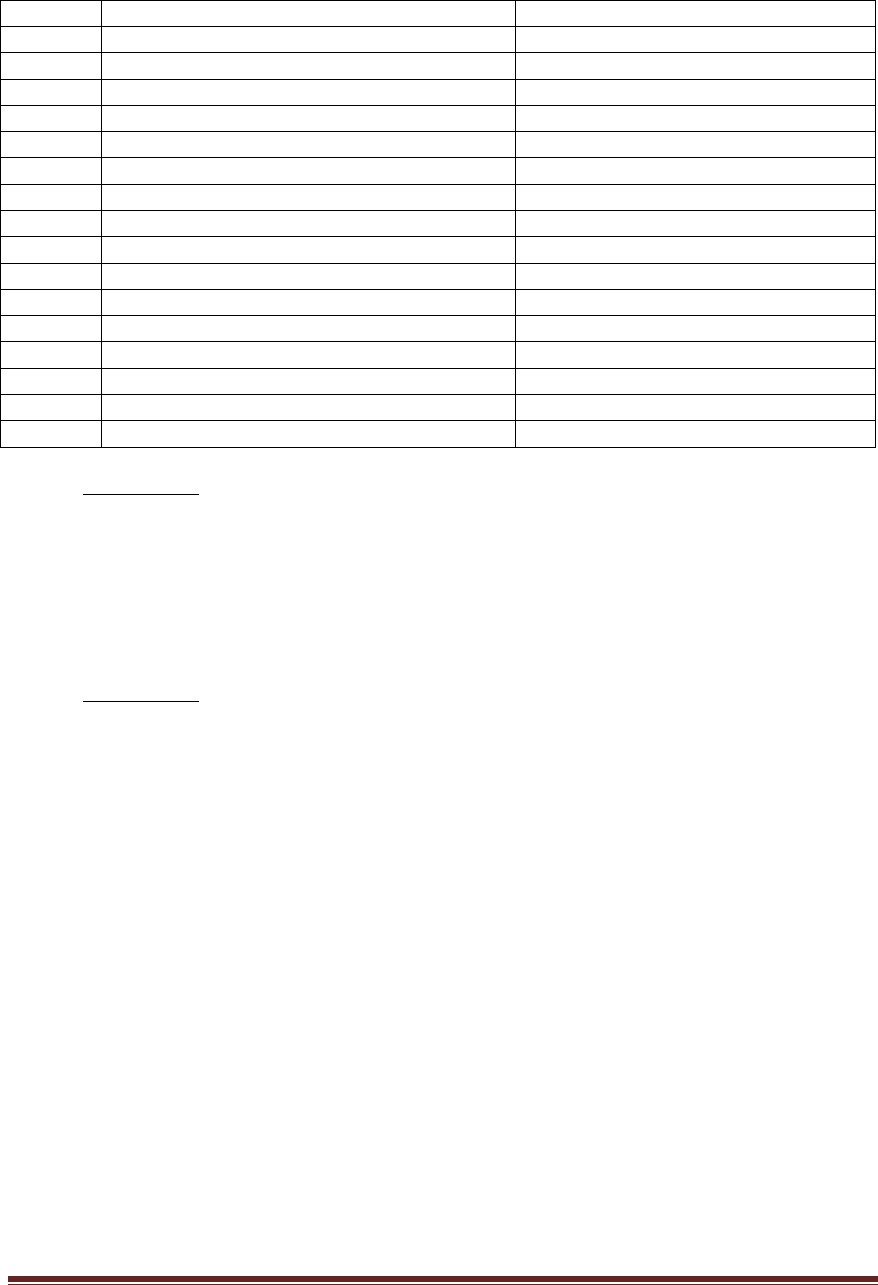
Applied Concepts 011-0131-00 rev 2 Page 61
B Format – All Speeds + Status
Byte # Description Value
1 Message Type 0x81
2 Status 1 (see detail below)
3 Status 2 (see detail below)
4 Patrol speed hundreds digit (ASCII)
5 Patrol speed tens digit (ASCII)
6 Patrol speed ones digit (ASCII)
7 Locked speed hundreds digit (ASCII)
8 Locked speed tens digit (ASCII)
9 Locked speed ones digit (ASCII)
10 Faster speed hundreds digit (ASCII)
11 Faster speed tens digit (ASCII)
12 Faster speed ones digit (ASCII)
13 Target speed hundreds digit (ASCII)
14 Target speed tens digit (ASCII)
15 Target speed ones digit (ASCII)
16 Carriage Return 0x0D
Status 1 byte
Bit 7-6: always = 01 (to force displayable ASCII characters)
Bit 5: lock status (0=no speed locked, 1=speed locked)
Bit 4: zone (0=opposite, 1=same/both)
Bit 3: fork mode (0=off/normal, 1=fork mode enabled)
Bit 2: always = 0
Bit 1: always = 1
Bit 0: transmitter status (0=off, 1=on)
Status 2 byte
Bit 7-6: always = 01 (to force displayable ASCII characters)
Bit 5-4: always = 00
Bit 3: fast lock status (0=no fast speed locked, 1=fast speed locked)
Bit 2: fast status (0=faster disabled, 1=faster enabled)
Bit 1: Low voltage (LoV) status (0=normal, 1=low voltage condition)
Bit 0: always = 0
The B Format is available on all of the RS-232 Speed Sensor models.
B Format messages are 16 bytes in length. The baud rate setting must be 4800 or greater to
ensure that a complete message is sent before the radar processes a new message to send.
When the Unit Resolution (Setting 21) is set for tenths, the speeds reported are multiplied by ten:
58.5 MPH is reported as 585. The decimal point is assumed. A B Format message can carry a
maximum speed in tenths of 99.9.
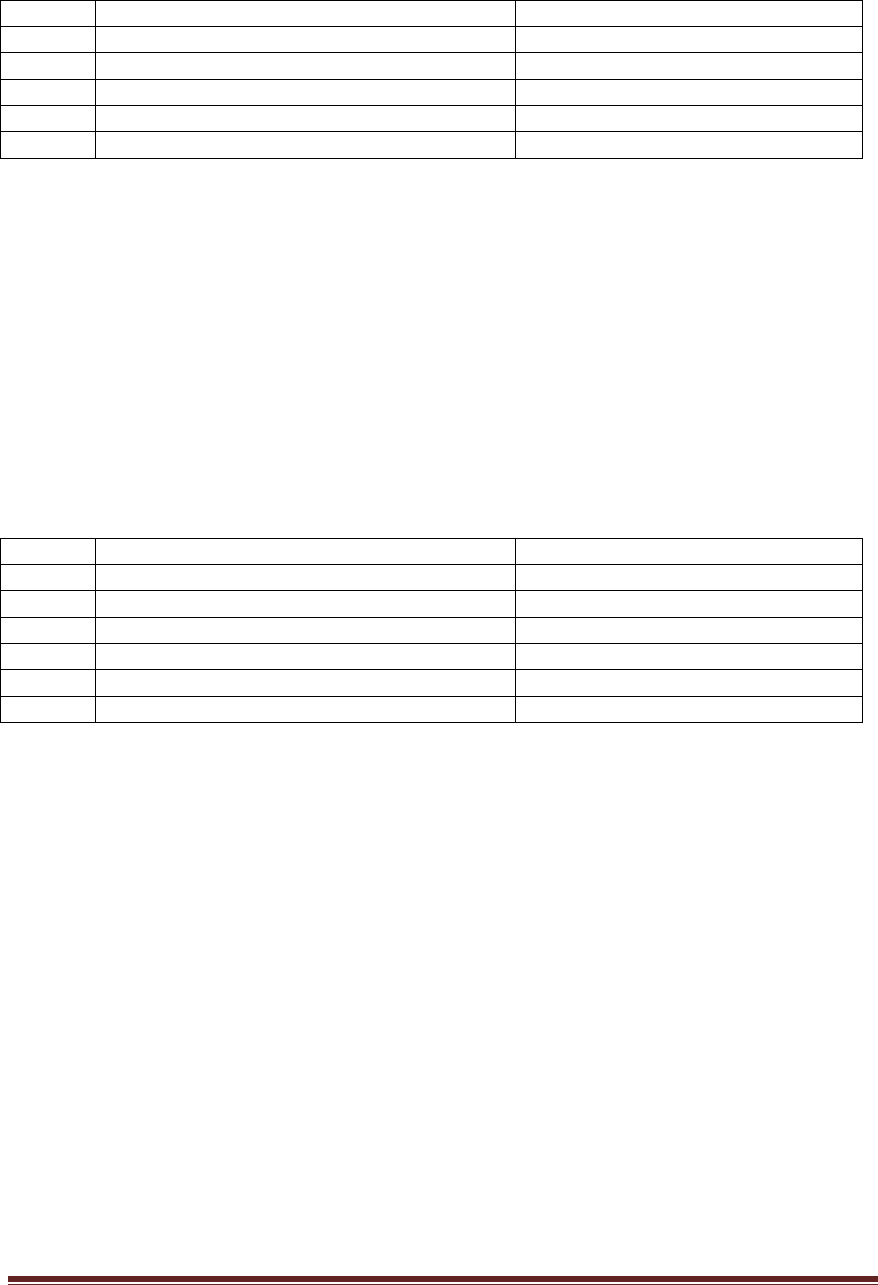
Applied Concepts 011-0131-00 rev 2 Page 62
D0 Format – Strong Target Speed Only, Optional Direction Byte
Byte # Description Value
1 Optional direction byte
2 Target speed hundreds digit (ASCII)
3 Target speed tens digit (ASCII)
4 Target speed ones digit (ASCII)
5 Carriage Return 0x0D
The D0 Format is available on the Stationary Speed Sensor model only.
D0 Format messages are up to 5 bytes in length. The baud rate setting must be 1200 or greater
to ensure that a complete message is sent before the radar processes a new message to send.
If the direction byte is not enabled (Setting 91), it is not sent, and the message will be a 4 byte
message. When enabled, the direction byte is ‘+’ for approaching, ‘-‘ for receding, and ‘?’ for
unknown.
When the Unit Resolution (Setting 21) is set for tenths, the speed reported is multiplied by ten:
58.5 MPH is reported as 585. The decimal point is assumed. A D0 Format message can carry a
maximum speed in tenths of 99.9.
D1 Format – Strong Target Speed Only, Optional Direction Byte, Checksum
Byte # Description Value
1 Optional direction byte
2 ‘S’ The letter ‘S’ (0x53)
3 Target speed tens digit (ASCII)
4 Target speed ones digit (ASCII)
5 Carriage Return 0x0D
6 Checksum
The D1 Format is available on the Stationary Speed Sensor model only.
D1 Format messages are up to 6 bytes in length. The baud rate setting must be 2400 or greater
to ensure that a complete message is sent before the radar processes a new message to send.
If the direction byte is not enabled (Setting 91), it is not sent, and the message will be a 5 byte
message. If enabled, the direction byte is ‘+’ for approaching, ‘-‘ for receding, and ‘?’ for
unknown.
The checksum is the sum of the preceding bytes truncated to the low order 7 bits.
When the Unit Resolution (Setting 21) is set for tenths, the speed reported is multiplied by ten:
8.2 MPH is reported as 82. The decimal point is assumed. A D1 Format message can carry a
maximum speed in tenths of 9.9. Due to this limited speed range, the tenths setting is not
recommended for this format.

Applied Concepts 011-0131-00 rev 2 Page 63
D2 Format – Strong Target Speed Only, Optional Direction Byte, Checksum,
Tenths
Byte # Description Value
1 Optional direction byte
2 Target speed hundreds digit (ASCII)
3 Target speed tens digit (ASCII)
4 Target speed ones digit (ASCII)
5 Decimal Point 0x2E
6 Target Speed tenths digit (ASCII)
7 Carriage Return 0x0D
The D2 Format is available on the Stationary Speed Sensor model only.
D2 Format messages are up to 7 bytes in length. The baud rate setting must be 2400 or greater
to ensure that a complete message is sent before the radar processes a new message to send.
If the direction byte is not enabled (Setting 91), it is not sent, and the message will be a 6 byte
message. If enabled, the direction byte is ‘+’ for approaching, ‘-‘ for receding, and ‘?’ for
unknown.
The Unit Resolution (Setting 21) should be set to tenths for this format to report speeds properly.
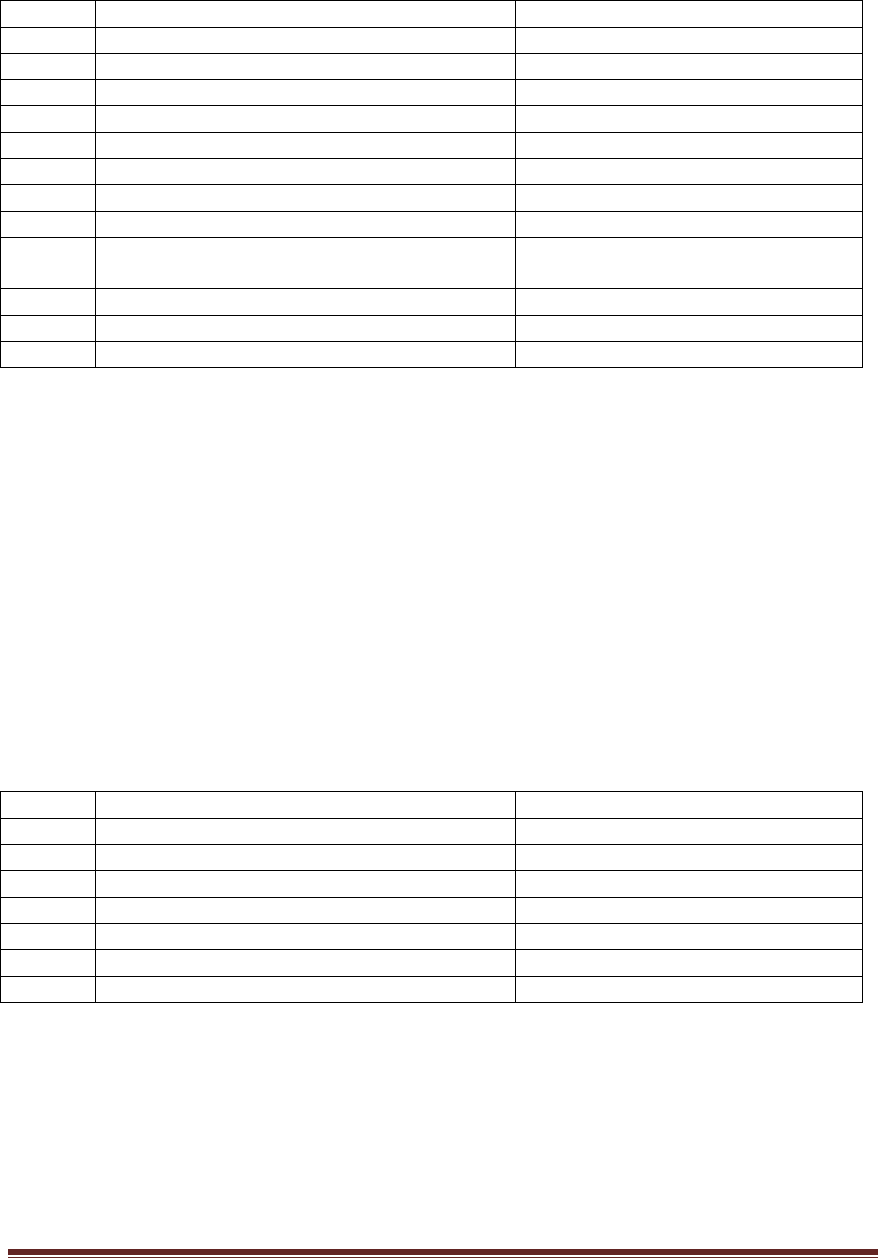
Applied Concepts 011-0131-00 rev 2 Page 64
D3 Format – Strong Target Speed Only, Optional Direction Byte, Relative
Amplitude, Tenths
Byte # Description Value
1 ‘*’ Asterisk (0x2A)
2 Optional direction byte
3 Target speed hundreds digit (ASCII)
4 Target speed tens digit (ASCII)
5 Target speed ones digit (ASCII)
6 Decimal Point 0x2E
7 Target Speed tenths digit (ASCII)
8 ‘,’ Comma (0x2C)
9 Relative Amplitude hundreds digit
(ASCII)
10 Relative Amplitude tens digit (ASCII)
11 Relative Amplitude ones digit (ASCII)
12 Carriage Return 0x0D
The D3 Format is available on the Stationary Speed Sensor model only.
D3 Format messages are up to 12 bytes in length. The baud rate setting must be 4800 or greater
to ensure that a complete message is sent before the radar processes a new message to send.
If the direction byte is not enabled (Setting 91), it is not sent, and the message will be an 11 byte
message. If enabled, the direction byte is ‘+’ for approaching, ‘-‘ for receding, and ‘?’ for
unknown.
Amplitude values are relative and in the range 0-160.
The Unit Resolution (Setting 21) should be set to tenths for this format to report speeds properly.
The Leading Zero Character (Setting 23) is forced to “zero” when using this format.
D4 Format – Strong Target Speed Only
Byte # Description
1 0x02 (HEX)
2 0x84 (HEX)
3 0x01 (HEX)
4 Target Speed (HEX)
5 0x01 (HEX)
6 0xAA (HEX)
7 0x03 (HEX)
The D4 Format is available on the Stationary Speed Sensor model only.
The bytes are sent just as above, in HEX format. The only variable is speed, which is the strong
target speed expressed in HEX format, e.g. 30 MPH would be sent as 0x1E.
D4 Format messages are 7 bytes in length. The baud rate setting must be 2400 or greater to
ensure that a complete message is sent before the radar processes a new message to send.
The D4 Format ignores the Unit Resolution (Setting 21). It only reports speeds in whole units.

Applied Concepts 011-0131-00 rev 2 Page 65
Enhanced Output Format – Hex All Speeds, Status
Byte # Description Value
1 Start ID 0xEF
2 Destination ID 0xFF (broadcast address)
3 Source ID 0x02
4 Packet Type 0x01
5 Payload Length (LSB) 0x0D
6 Payload Length (MSB) 0x00 (length = 0x000D = 13 bytes) (bytes 7-19)
7 Command ID 0x00
8 Antenna Number 0x01
9 Target Speed (LSB) Speed of strongest target is 16-bit number
10 Target Speed (MSB) (see above)
11 Faster Speed (LSB) Speed of faster target is 16-bit number
12 Faster Speed (MSB) (see above)
13 Locked Speed (LSB) Locked speed (strong or fast) is 16-bit number
14 Locked Speed (MSB) (see above)
15 Patrol Speed (LSB) Patrol speed is 16-bit number – only valid in
“moving” mode
16 Patrol Speed (MSB) (see above)
17 Direction (see detail below)
18 Status (see detail below)
19 Configuration (see detail below)
20 Checksum (LSB) The checksum should equal the 16-bit sum of
pairs of bytes in LSB, MSB order starting with
byte #1 as the first LSB through and including the
last byte before the Checksum (in this case, byte
#19). In the case of an odd number of bytes,
0x00 is used as the last MSB value. (See
example packet below.)
21 Checksum (MSB) (see above)
Direction byte
Bits 7-6: patrol speed direction (0=unknown, 1=forward, 3(-1)=reverse)
Bits 5-4: locked speed direction (0=unknown, 1=closing, 3(-1)=away)
Bits 3-2: fast speed direction (0=unknown, 1=closing, 3(-1)=away)
Bits 1-0: target speed direction (0=unknown, 1=closing, 3(-1)=away)
Status byte
Bit 7: test result (0=success, 1=failure)
Bit 6: fork mode (0=off/normal, 1=fork mode enabled)
Bits 5-3: units (000=MPH, 001=km/h)
Bit 2: transmitter status (0=off, 1=on)
Bit 1: strong lock (1=locked speed is strongest target)
Bit 0: fast lock (1=locked speed is faster target)
Configuration byte
Bits 7-3: always = 00000
Bits 2-1: zone (00=same,01=opposite,10=bi-directional)
Bit 0: mode (0=stationary,1=moving)

Applied Concepts 011-0131-00 rev 2 Page 66
The Enhanced Output Format is available on all of the RS-232 Speed Sensor models.
Enhanced Output Format messages are 21 bytes in length. The baud rate setting must be 4800
or greater to ensure that a complete message is sent before the radar processes a new message
to send.
When the Unit Resolution (Setting 21) is set for tenths, the speeds reported are multiplied by ten:
58.5 MPH is reported as 585. The decimal point is assumed. Since the speeds are sent as hex
values, an Enhanced Output Format message can easily carry the highest measurable speed of
321 km/h (or 3210 in tenths).
EXAMPLE PACKET (Enhanced Output Format)
Byte # Description Example Values
1 Start ID 0xEF
2 Destination ID 0xFF
3 Source ID 0x02
4 Packet Type 0x01
5 Payload Length (LSB) 0x0D
6 Payload Length (MSB) 0x00
7 Command ID 0x00
8 Antenna Number 0x01
9 Target Speed (LSB) 0x37 (55 MPH)
10 Target Speed (MSB) 0x00
11 Fast Speed (LSB) 0x4B (75 MPH)
12 Fast Speed (MSB) 0x00
13 Locked Speed (LSB) 0x37 (55 MPH)
14 Locked Speed (MSB) 0x00
15 Patrol Speed (LSB) 0x3C (60 mph)
16 Patrol Speed (MSB) 0x00
17 Direction 0x5D
18 Status 0x06
19 Configuration 0x01
20 Checksum (LSB) 0x51
21 Checksum (MSB) 0x09
Checksum = 0x0951 (truncated to the low order 2 bytes) = 0xFFEF + 0x0102 + 0x000D
+ 0x0100 + 0x0037 + 0x004B + 0x0037 + 0x003C + 0x065D + 0x0001
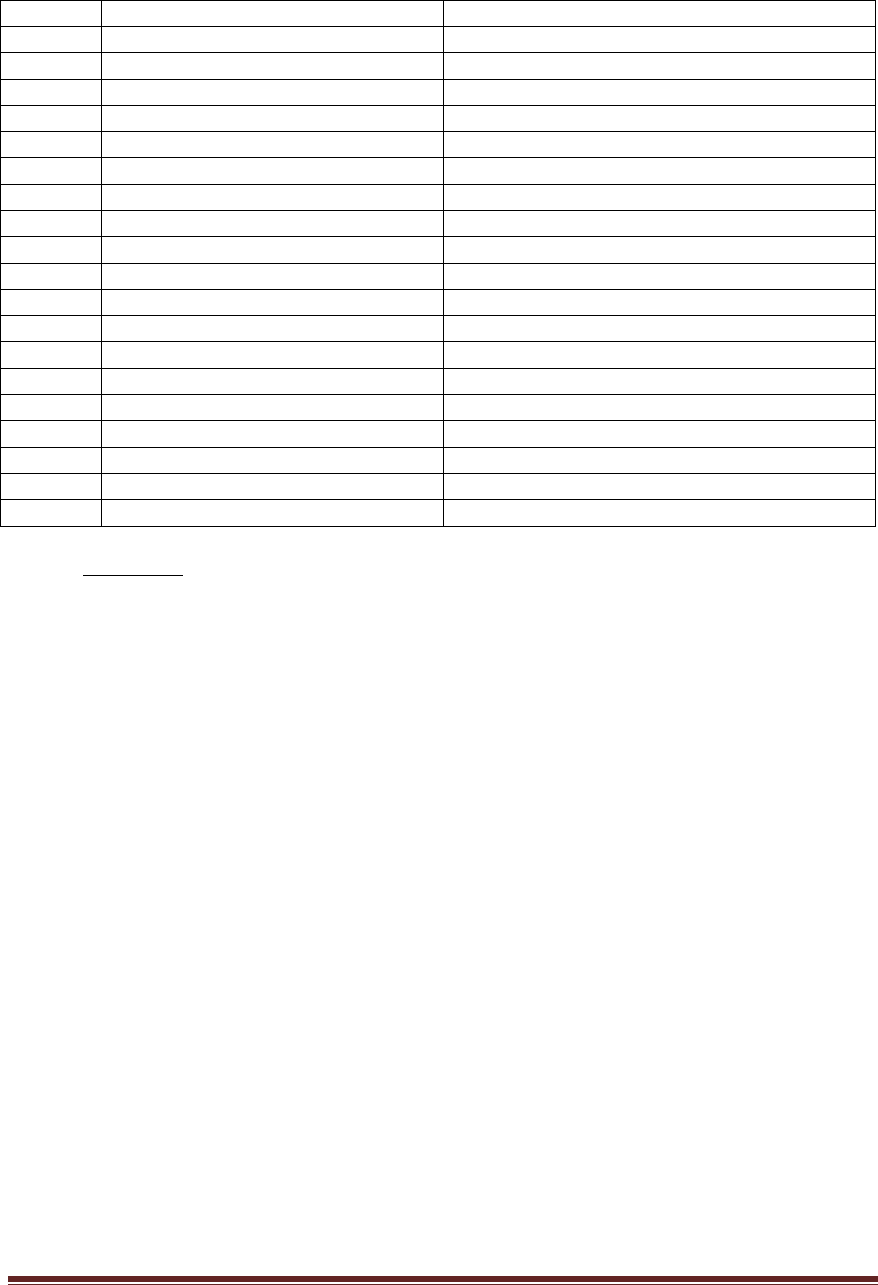
Applied Concepts 011-0131-00 rev 2 Page 67
S Format – Target Speeds, Status
Byte # Description Value
1 Message type 0x83
2 Faster target direction ‘A’ = “away”, ‘C’ = “closing”
3 Faster target speed Hundreds (100) ‘0’ – ‘9’ (ASCII)
4 (same) Tens (10) ‘0’ – ‘9’ (ASCII)
5 (same) Ones (1) ‘0’ – ‘9’ (ASCII)
6 (same) Tenths (0.1) ‘0’ – ‘9’ (ASCII)
7 Strongest target direction ‘A’ = “away”, ‘C’ = “closing”
8 Strongest target speed Hundreds (100) ‘0’ – ‘9’ (ASCII)
9 (same) Tens (10) ‘0’ – ‘9’ (ASCII)
10 (same) Ones (1) ‘0’ – ‘9’ (ASCII)
11 (same) Tenths (0.1) ‘0’ – ‘9’ (ASCII)
12 Strongest target strength Hundreds (100) ‘0’ – ‘9’ (ASCII)
13 (same) Tens (10) ‘0’ – ‘9’ (ASCII)
14 (same) Ones (1) ‘0’ – ‘9’ (ASCII)
15 Channel signal strength ratio Hundreds (100) ‘0’ – ‘9’ (ASCII)
16 (same) Tens (10) ‘0’ – ‘9’ (ASCII)
17 (same) Ones (1) ‘0’ – ‘9’ (ASCII)
18 Status (see detail below)
19 Carriage return 0x0D
Status byte
Bit 7-6: always = 01 (to force displayable ASCII characters)
Bit 5: always = 0
Bit 4: Fork Mode (1=enabled, 0=disabled)
Bits 3-0: always = 0
The S Format is available on the Stationary and Traffic Speed Sensor models.
S Format messages are 19 bytes in length. The baud rate setting must be 4800 or greater to
ensure that a complete message is sent before the radar processes a new message to send.
Strongest target strength values are relative and in the range 1-32.
Channel signal strength ratio is a measure of the directionality of the target. A higher number is
more directional.
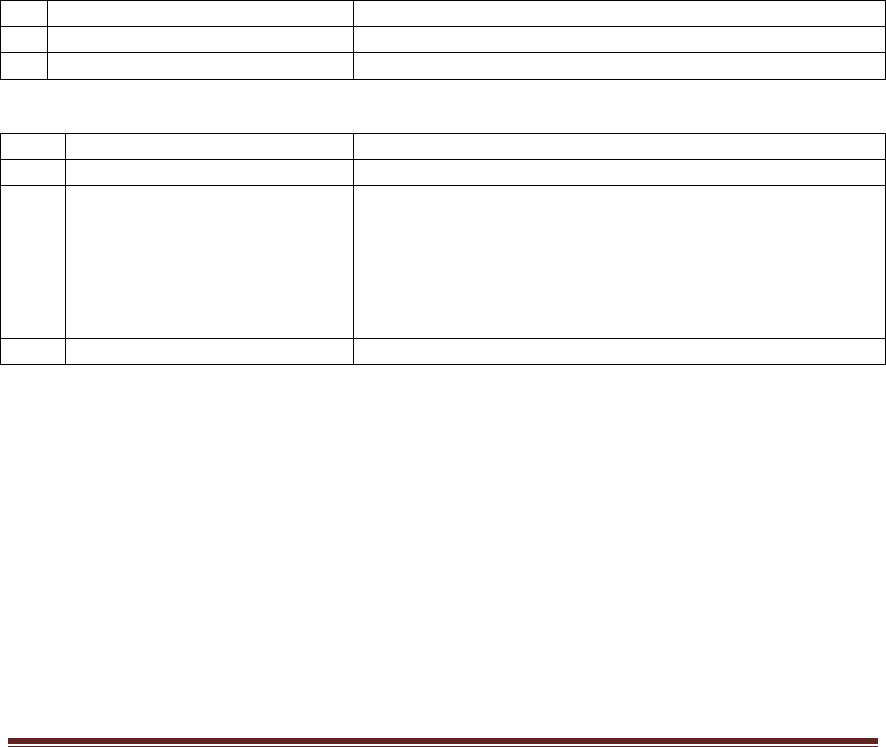
Applied Concepts 011-0131-00 rev 2 Page 68
9.1.1.1.1.1.2 Handshake Speed Data Protocols
When a handshake (polling) protocol is selected, the Speed Sensor sends only one
speed message for each speed data request (poll) it receives from the controller.
EE Polling
The simple EE Format Request is a two byte message as shown below. The response
from the Speed Sensor is a four byte message carrying fields for live speed (in
hexadecimal) and direction. Since there is no addressing in the request message, it is
assumed that it is directed to a unit with a Speed Sensor ID of 2; and only a unit with
ID=2 responds to it. Both RS-232 and RS-485 models respond to EE Format polling.
The EE Format only reports one speed. For the Traffic Speed Sensor and Speedometer
Speed Sensor, the patrol speed is reported. For the Stationary Speed Sensor, the
strongest target speed is reported.
Refer to Section 7.9 for instructions on configuring the demo application to poll for EE
Format responses.
EE Format Request (from Controller to Speed Sensor)
# Description Value
1 Start ID 0xEE
2 Check byte 0x12 (0xEE + 0x12 = 0 (mod 256))
EE Format Response (from Speed Sensor to Controller)
# Description Value
1 Start ID 0xEE
2-3 Speed Bit 15 – valid bit (1=valid speed)
Bit 14-13 – direction (11=away,
00=neither//fork,
01=closing
Bit 12 – unused
Bit 11-0 – speed in selected units and unit resolution
4 Check byte Bytes 1-4 sum to 0 (mod 256)
EA Polling
EA Polling Request messages are like those for EE, but they contain Destination and
Source IDs as shown below. The source ID is always 1 for the controller. The
destination ID can be any value in the range from 2 through 254, and only a Speed
Sensor with that address will respond. Its response to the EA poll is to send a single
speed message in the format selected by the Message Format setting (30): EE,
Enhanced Output, B, S, F, A, AF, D0, D1, D2, D3 or D4. Only the Stationary RS-485
model responds to EA polling.
The demo PC application does not support EA polling.

Applied Concepts 011-0131-00 rev 2 Page 69
EA Polling Request (from Controller to Speed Sensor)
# Description Value
1 Start ID 0xEA
2 Destination ID 0x02 – 0xFE (2-254)
3 Source ID 0x01
4 Check byte Bytes 1-4 sum to 0 (mod 256)
Polled Mode for D0-D4 Formats
The D0-D4 Formats described in Appendix A may also be used in polled mode. If polled
mode is selected (Setting 90), sending a 3 byte poll string of “*P<cr>”, (0x2A 0x50 0x0D)
causes a return of the current target speed in the selected format. These formats are
only available in the RS-232 Stationary model.
The demo PC application does not support polling in the D0-D4 formats.
10 FCC Requirements
This device is approved as an intentional radiator under FCC Part 15 with FCC identifier
IBQACMI007.
No additional licensing is required to operate this device.
Operation is subject to the following two conditions:
(1) This device may not cause harmful interference, and
(2) This device must accept any interference received, including interference that may cause
undesired operation.

71
The S Speed Sensor Radars
are Manufactured by Applied Concepts, Inc.
Copyright © 2010 by Applied Concepts, Inc.
STALKER RADAR
2609 Technology Dr.
Plano, TX 75074 USA
1-800-STALKER
(1-800-782-5537)
(972) 398-3750 Sales
(972) 398-3751 Fax
www.stalkerradar.com

72
Made in U.S.A *011013100* 011-0131-00 Rev. 1